
- How You Can Help
- Ways We Give Back

Simple Solutions to Track Missing Work
Tracking & collecting missing work may just be the bane of many teachers’ existence. It can be so hard to keep everything straight & incredibly frustrating trying to hound students to get it turned in.
Aside from simply throwing zero’s in the gradebook and moving on, there’s no simple solution. But I do have some tried-and-true suggestions for how you can take this big problem and turn it into something much more manageable.

To make this plan work smoothly, you’ll need two classroom helpers: an absence secretary and a class secretary. Simply choose responsible students that tend to finish their own work early & ask if they’ll help you out. Once you train a student, I’d recommend keeping the same secretary for at least a quarter before switching up roles.
Tracking What Work is Missing:
*Class Secretary makes a list of what’s missing: When papers are collected, s/he goes through them & sees what is missing. S/he then writes down whose paper is missing on a post-it note or cover sheet. [Ideally, the class secretary would also know who has been absent & would mark which papers are actually late & which are missing due to absence.]
*Keep a running total of what’s missing: Each day, you quickly scan the post-it notes or cover sheet & record missing work in your gradebook. You also record what is missing either in a Word doc that can be printed & posted in the classroom or on a dry-erase board that is posted in the classroom. (If you are a paperless school, you can also use a Google Doc.) This provides a running tally of any work that is missing. For absent work, the teacher records on the document or white board when the assignment is due. ( Click here to have an example form sent to you . )
*Students fill out a form each time they’re missing an assignment: Students who don’t have an assignment finished (whether they’re late or absent) must fill out a (brightly colored) form saying why they don’t have it & when they plan to finish it. They turn this in when the rest of the class turns in their assignment. This makes it easier for the class secretary (and/or you) to see whose paper is missing. ( Click here to get an editable sample form . )
Letting Students Know What is Missing:
* Keep extra copies: Always run off a couple extra copies of worksheets/homework assignments & have a designated spot to keep them. Train students that when they lose a worksheet, they can should check the folder instead of asking you for a new one.
*Absence secretary tracks what you do in class: Your absence secretary should have a form to fill out for each student who is absent that records what was covered in class, any homework, and any assessments they need to make up. These forms are then placed in a designated place (or in the classroom out-box if that is part of your classroom procedure). The absence secretary staples any papers to the form. S/he also is responsible to collect the extra copies & place them in the designated spot.
* Absent students look to see what they missed: Absent students are required to collect their form that the absence secretary filled out for them. They must also check the missing work document/board to see when items are due. ( Click here to get an editable sample form . )
Making Up Assessments
*Create a Testing Center (middle school/high school): If your school doesn’t have a testing center, talk to your administration about starting one. Testing centers can take place in study hall or in a separate monitored room.
When a student misses an assessment, teachers would write on the top of the assessment the date it must be taken by & turn in that test to the testing center. Students are then responsible to go to the testing center during their open periods to make them up.
Please note that study hall teachers or testing center monitors would need to have good policies to ensure students aren’t cheating (e.g. student must sit in a specific spot, desk must be cleared, other students aren’t allowed to talk to them during testing, etc.)
Collecting & Updating Work That’s Turned In:
* Track daily what’s turned in : Have a designated in-bin that is only for work that absent/late work. Go through that bin daily to update your gradebook & the missing work document/board. This does not mean it needs to be graded right away, just updated that it’s been turned in. These papers could then be placed in a file and graded weekly or bi-weekly. Let parents & students know that if papers are turned in late they are not necessarily graded as quickly.
Alternatively, you can have students turn in absent/missing work to the class secretary who will update the document/board for you. Or students could cross their own name off the list designating they’ve turned it in.
What procedures have you found helpful for tracking missing work? Share them with a comment below.
And to make things a bit easier for you, I’ve put together an editable example of the absence secretary form, “I don’t have my work because” form, and the running total of missing work document. Click here to get all 3 forms now .
And if you’d like more information about teaching students procedures, check out our free training How to Reduce Disruptions without Yelling, Begging, or Bribing

You may also find this related post helpful: “ 17 Ways to Get Students to Actually Do Their Work “
What to Read Next
Make Learning Memorable with Tech (and Without Overwhelm)
How to Love Your Students through Classroom Management
Handling AI in the Classroom: AI Ethics for Education
I alphabetize papers as they come in, and post “missing” designations in the grading program. Every Friday, I print out a list of missing work and circulate the list in class. If I don’t have time to copy the list, I display it on the Smart board. I also have a spot on the board where I count down the days to the end of the quarter. When students are working, I have the opportunity to speak to the chronic latecomers and get them back on track. I have a deadline for late work, and the grade is set at 50% of the grade they would have gotten had they handed the work in on time. I don’t give homework, so I can make sure that the students understand what they are doing as I circulate.
We have a time for “ketchup & pickles” every 2-3 weeks. (I list missing assignments on the board as needed, but I make sure to update it the morning that K & P will happen.) Students who are missing work are “Ketchups” (catch up on work) & those who are not are “Pickles” (pick a fun activity). Building in this extra time helps me stay caught up without getting stressed!
I have heard this saying but nobody has explained what that meant. I will most certainly have a ketchup and pickles option.
Having a “Late Work” manila folder stapled to the wall is a life saver, as students turn in late work their, and it keeps it separate from other, on-time work. When students are absent, I write their name on that day’s handouts and homework at the beginning of class. I then put those papers into that period’s designated “Absent” folder on the wall, and students pick up their work when they come back. Writing their name on the handouts in my handwriting, also lets me know that when a student turns it in in the “late work” folder, it’s actually not late, they were just absent.
Thanks all! So helpful, including article.
Session expired
Please log in again. The login page will open in a new tab. After logging in you can close it and return to this page.

Why it’s hard for students to “just turn in” missing assignments, and how to get them unstuck
Mar 29, 2023 | Blog

With the end of the semester on the horizon, many students may feel overwhelmed by low grades or feeling behind in some of their classes.
As a parent, it can be stressful to see that your student has overdue work, or get notifications from their teacher that they’re missing assignments.
It’s even more frustrating when you’ve told them over and over again how important it is to “just turn it in”…but the work is still showing up as missing.
The reality is that no matter how simple it might seem to an outside observer, doing missing work is almost never as easy as “just getting it done.” If they haven’t done the work yet, there’s a good chance that something is getting in their way.
If you can figure out what the problem is before jumping in to help them (or make them) do the work, you’ll dramatically increase your chances of success.
In our experience, there are usually 3 main reasons students resist submitting their missing work…even when it seems like “just turning it in” would be SO much easier!
Reason 1: They think it won’t make a difference
Once the due date for an assignment has passed, students often de-prioritize it and move on to focus on upcoming assignments instead. It’s tempting for students to justify this by thinking “there are lots of other assignments, missing one or two won’t matter.”
But what they often don’t realize is that because of the way most grading scales are weighted, even one or two zeros can have an enormous impact on their grade. Showing students the difference it makes to turn in just a few assignments can increase their motivation to get the work done.
Here’s an example of the difference it can make to turn in just a few missing assignments before the end of the semester:
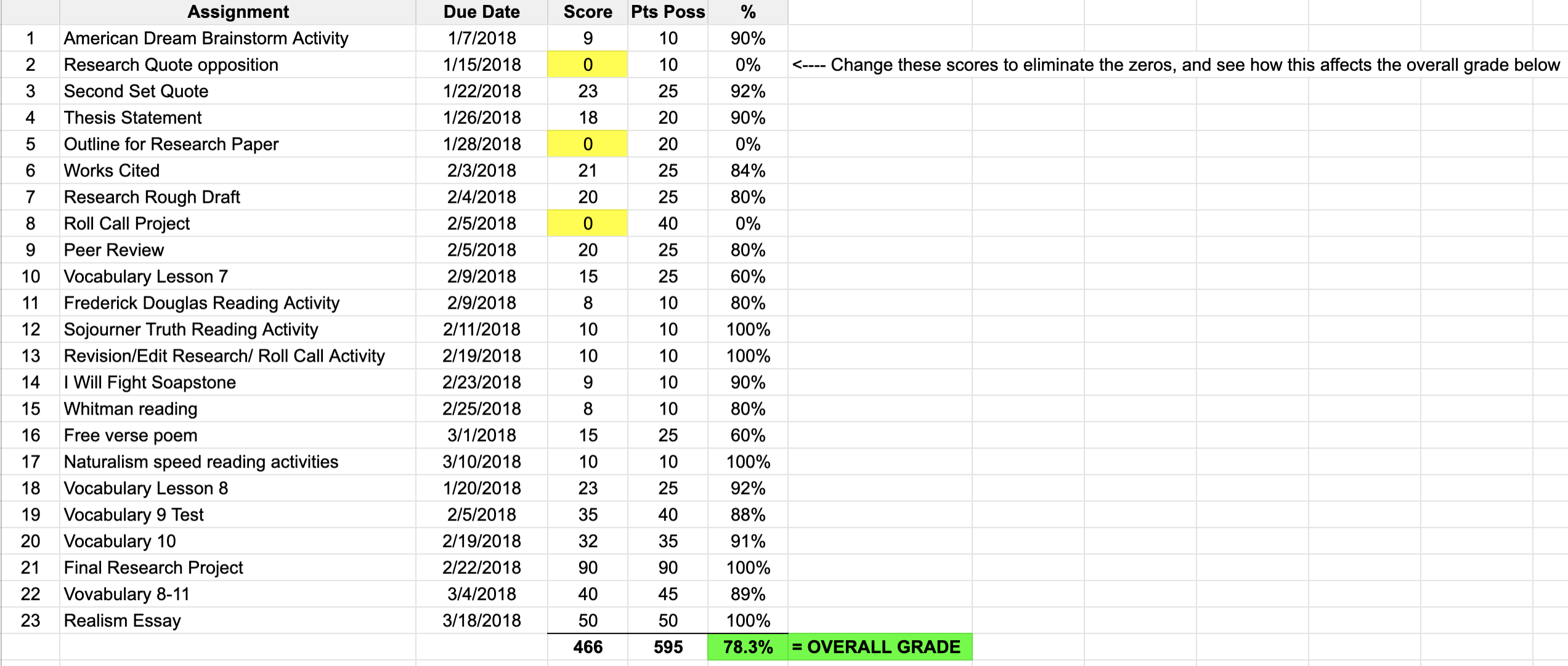
Overall grade with 3 missing assignments: 78.3%
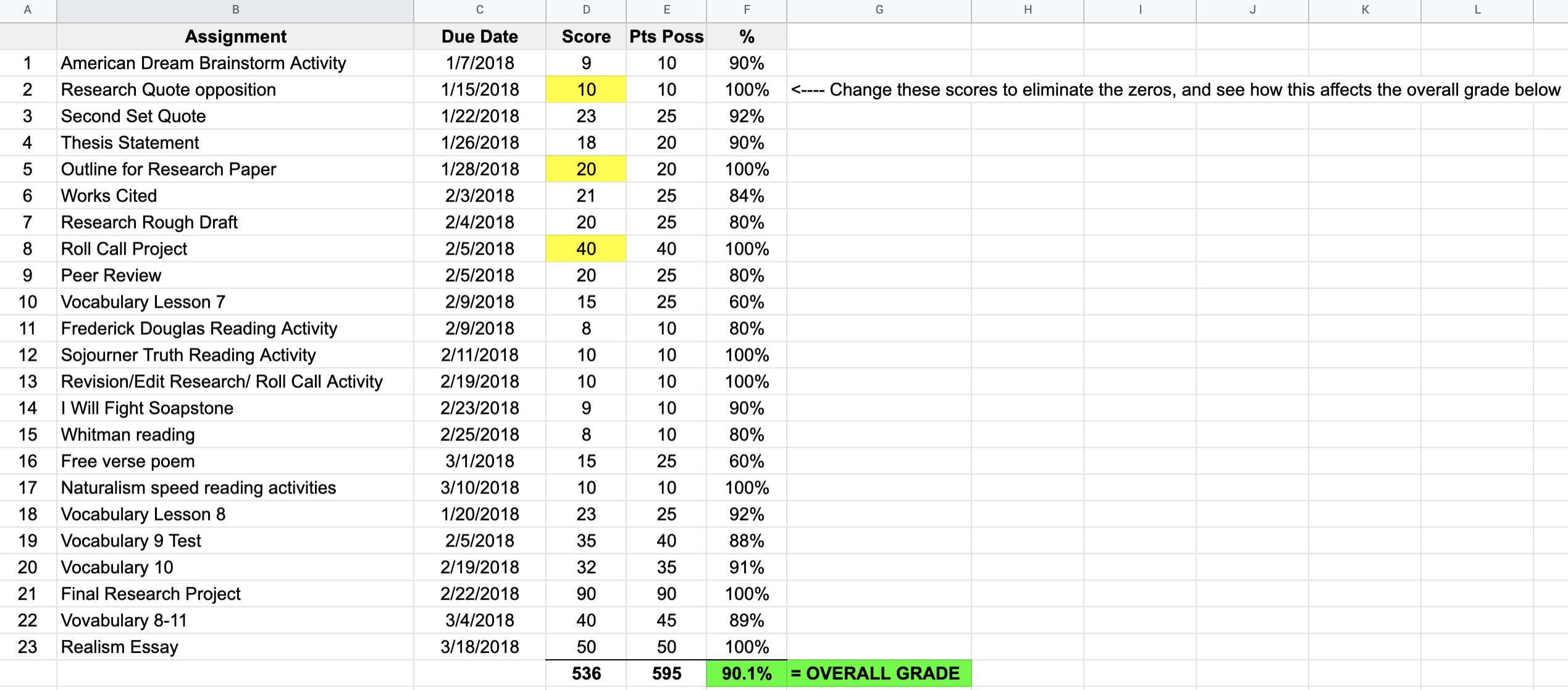
Overall grade when assignments are turned in: 90.1%
It’s hard for students to calculate these averages in their head, so it can be really powerful for them to run the numbers and see firsthand exactly how much they have to gain from making up their missing assignments.
When we do calculations like this with our students, they are almost always surprised by how much this makeup work could improve their grades, and feel much more motivated to submit the assignments when they can see for themselves the difference it will make.
Reason 2: They think it’s too late
Another reason students often resist doing makeup work is that they think it’s too late to get credit for it.
Even if they’ve done the math and know that submitting the work would make a difference in their grade, they still won’t want to turn it in if they think the teacher won’t accept it.
Especially for introverted or anxious students, it can be very intimidating to have conversations with their teachers. They might think they’ll get in trouble for asking to submit their work late, or worry that the teacher will say “no.”
The good news is that many teachers are flexible with their late work policies and allow students to turn in overdue assignments even when it is past the “official” deadline to submit them.
So if students can find the courage to ask for help, there is a good chance that their teachers will respond positively and allow them an opportunity to make up the work.
For students who are struggling to reach out to teachers, we often find it is helpful to roleplay these conversations in coaching sessions if they’re not sure what to say, or work with them to email their teachers if they’re not sure what to say.
Reason 3: They feel overwhelmed
Students who are behind on their work often have challenges keeping track of due dates, managing time, breaking down complex assignments, prioritizing work, staying focused, or following through with plans….which is why they fell behind in the first place.
These challenges can become even more daunting when they are behind in their classes, and trying to complete makeup assignments on top of their normal workload.
This can feel so stressful that a lot of students avoid or put off doing makeup work even when they know how much it would improve their grade.

For these students to get their work submitted, it’s essential to help them find ways to…
- Break down the assignments so they have a realistic plan for getting the work done that they’re confident they can actually follow through with
- Lower the stress they feel while they are doing the work so they will be less tempted to avoid it
- Visualize the progress they are making so they can see that their efforts are making a difference
Providing support
When students have a lot of makeup work to complete, having some additional support to help them work through it can be invaluable.
For some students, this may mean finding a tutor to help them with the content they didn’t understand when their teacher was first presenting the material.
For other students, having a family member or friend nearby as a source of moral support to keep them company while they are working (and a motivating reward to look forward to as soon as the work is completed) can be enormously helpful.
Other students may benefit from working with an academic coach to help them get unstuck and started on their missing work. Sometimes, having someone else who is not a family member step in to help can reduce stress and conflict at home and make it easier for students to take the steps they need to get back on track in their classes. If you think this type of support would be helpful for your student, please feel free to reach out and we’ll be happy to help!

Novels & Picture Books

Anchor Charts

- Classroom Organization
- Back to School
Tips for Organizing Student Work
By Mary Montero
Share This Post:
- Facebook Share
- Twitter Share
- Pinterest Share
- Email Share
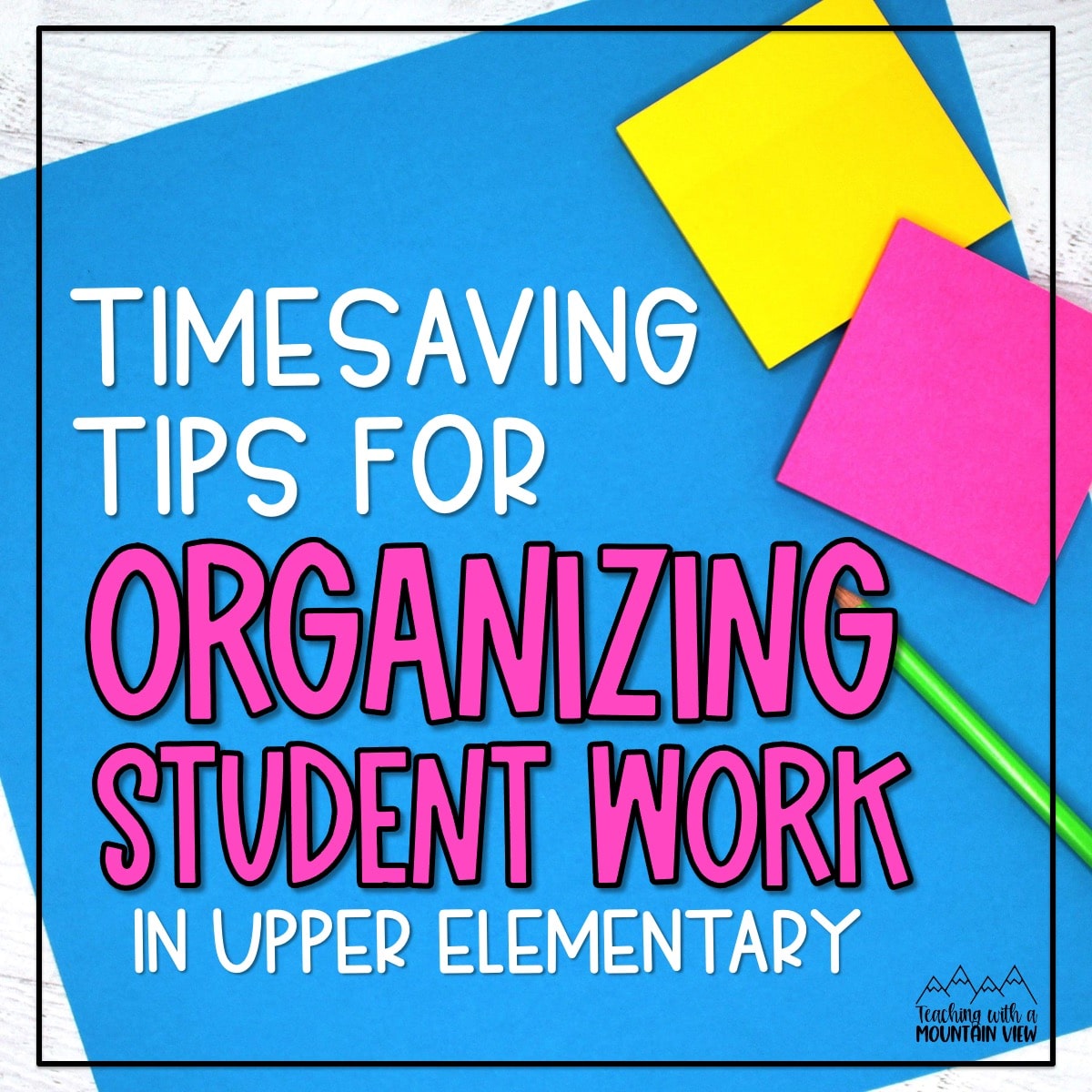
Whether you’re a new teacher or have many years of experience, odds are you still find yourself trying to find your desk under all.that.paper from time to time. Then you add in students who forget to turn in assignments and it can be really overwhelming to sort through who needs what. However, the good news is, with a little bit of planning and organization, you can minimize these challenges and develop a system for organizing student work.
Whether it’s helping absent students catch up, tracking missing assignments, or just finding the best way to sort papers that need to be graded… organizational systems are always a popular topic of conversation in our Inspired In Upper Elementary Facebook group . Here are some of my own tips and tricks, as well as contributions from our group members, to help you stay on top of the paper trail so you can spend more time teaching and less time stressing.
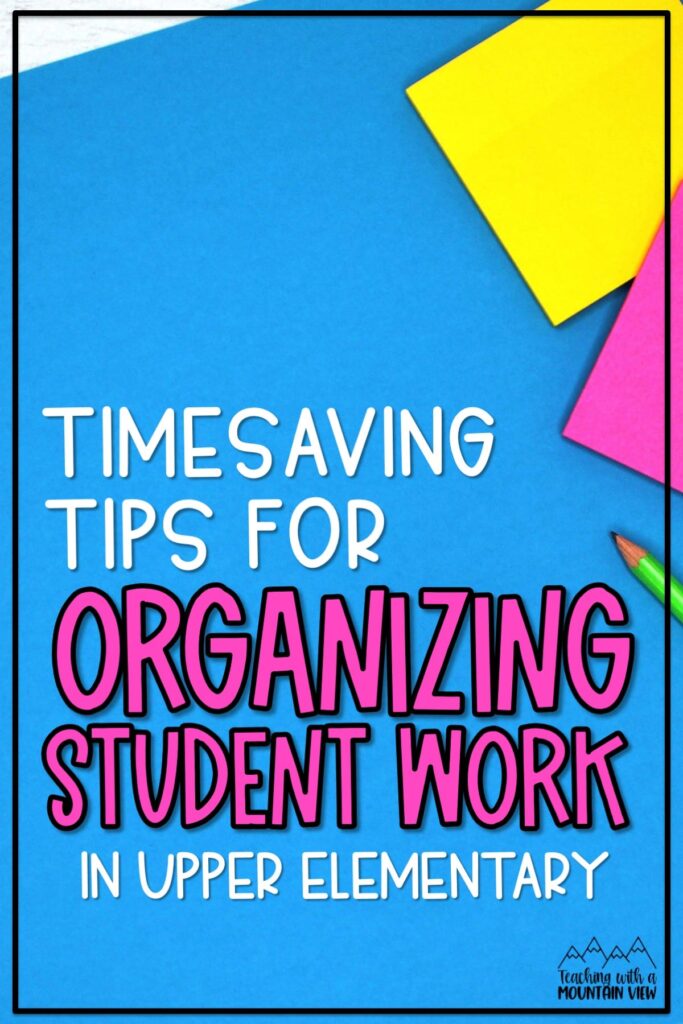
Students Who Receive Pull-Out Services
First of all, I always recommend having different makeup policies for students who miss classroom work due to pull-out services. If possible, I am careful to arrange my schedule around IEP and gifted services so that my students don’t always miss the same type of classroom instruction. This makes it easier to excuse occasional missed assignments. As a gifted and talented teacher , I always encourage teachers to consider their pull-out services their work for that time period. I believe in giving different work instead of more work, though this may not always be possible.
Sometimes it’s also possible to coordinate schedules seamlessly. For example, one of my IEP clusters received daily phonics pull-out services at the same time we were working on phonics in our general education classroom. This year, all of our pull-out services (reading, math, and gifted and talented) happened at the same time. Because of this, those students never had to make up any classroom work from that same time.
Laura B. shared this great advice in our group, “As soon as students leave for services I have them hand me their papers and I make a note on them, drawing a line where I feel they should have stopped, which is dependent on the individual student. I give them the percentage they received adjusted for work completed.”
Procedures For Collecting Assignments
It sounds really simple: complete an assignment, turn it in, and receive a grade. However, we all know that feeling when we go to grade a set of papers and realize several are missing. These systems can help with that!
First, set up a specific area in your classroom where students can turn in their work. This will help you ensure that all the work is in one place, and it will make it easier for you to collect it when you need it.
After trying many systems, I’ve found that subject-specific trays or color-coded folders (Amazon affiliate links) work the best. When I had a free minute during the day, I’d pull that tray and quickly sort the papers alphabetically. We used a numbering system where each student added their classroom number beside their name, which made this process even faster. Then I added a sticky note to the top of the pile with the names or numbers that were missing. As students turned work in late, they crossed their name off the list. By doing this, you can quickly track which students have turned in their work and who needs a reminder. I found that collecting papers the same day greatly reduced the number of missing assignments. As more time passed, papers were accidentally taken home, got lost in the blackhole of student desks, were accidentally thrown away, etc. Oftentimes the assignment was finished and just never made it to the turn in location, so this method helps tremendously.
Teachers in our Facebook group had similar suggestions. Here are a few:
“I have done this with clothespins on the side of a tub. The kids who haven’t turned them in will still have their clothespin on the tub.” Nancy K
“I use dividers with pockets and hot glue them onto a wall. Each kid has one so I can see at a glance who didn’t turn it in. Then when they get collected they are in the order of the gradebook so that’s a bonus!” Taylor B.
“Make it a daily job. My students put their # on papers. The student who has that job goes through to make sure all numbers are there. They report to me if a number is missing.” Colleen M.
Missing and Incomplete Assignments
As a classroom teacher, you already know how tricky it can be to keep track of missing assignments and provide opportunities for students to complete the work. I’ve found that it’s much easier to stay on top of assignments throughout the grading period instead of waiting until the last minute. I personally track missing assignments daily and provide frequent opportunities for students to catch up..
How I Keep Track of Missing Assignments
- I keep the sticky notes with the name of the assignment and missing names/numbers on my desk. This is an efficient way to see at-a-glance who has missing work each day.
- A spreadsheet is a great way to track missing assignments over time. I keep a main sheet with all students’ names that I can print (or use digitally) as-needed for various tasks during the year (permission slips, assignments, etc). I use one for a running list of missing assignments.
- I enter grades into our digital gradebook weekly. Any assignments marked as missing can be printed or emailed to parents.
- Consider using digital tools such as Google Classroom, Seesaw, or Edmodo to cut down on paper assignments. You can collect work, grade assignments, and provide feedback all in one place.
How Students Manage Missing Assignments
- Each student has a color-coded folder for incomplete assignments. If they finish other tasks early, they can work through items in their folder next. This specific folder reduces lost papers!
- We have weekly choice time where students can select a center, play brain games, work on projects, etc. All missing assignments must be completed first before choosing a different activity.
- In years where I’ve been lucky enough to have a teaching assistant or parent volunteers, I’ve used some of their time to help students with these assignments.
More Tips From Teachers
“Post everything, even paper assignments, in Google classroom and have students mark it as submitted when they finish it.” Kristine A.
“Google Classroom keeps track of what has been turned in and what hasn’t. You can set up due dates and if students miss a due date it gets marked as missing. It allows you to return work that you have graded or return work before you grade it if the student turned it in unfinished or incomplete. When I grade my student’s work it gives me a list of those who have not turned in the assignment. I click one button and it puts them all into a BCC email. I add their parents to the mass email too and then send a message saying this work hadn’t been turned in. You need to train your students to check their email regularly. The parents usually see the email first. Google Classroom also gives the kids a To Do list that shows current assignments, as well as all late or missing work that needs to be done. Parents can also sign on as a guardian to get a weekly report of their child’s work history.” Kerri C.
“I make students keep a contract/agenda/must do-may do sheet. It has all required assignments for the week and any extra items they can do if finished early. When students turn it in, they get a piece of candy (you could do tickets, points, etc). I’ve had the best success with it the past few years. I keep a checklist on top of the stack and mark off their name when they turn it in. This helps me see quickly who hasn’t finished.” Angie C.
“I do a weekly 30-minute block for catch up, rework, or complete. We clean out desks and organize as a class before the 30 minute block. Students who are done have a choice of quiet activities to do—games, Legos, art. It’s a chance for me to check in with kids and catch missing/late work. It’s also a time for kids to rework something that didn’t meet expectations. I also have a missing work board that is updated throughout the week. Students can work on missing/unfinished work if they finish something early. To get their name off the missing work board, they complete a very brief work habit reflection slip that is signed by me upon reviewing work with them. There are more names and the need for explicit teaching in work habits at the beginning of the year. Kids learn how to monitor time and work completion. Kids need explicit teaching and practice with work habits.” Tracy S.
Work for Students Who Were Absent
We do a lot of learning every single day, and not all of it can easily be made up when absent students return. I recommend thoughtfully considering which missing assignments need to be completed and which ones can be skipped. I also evaluate which assignments need to be completed together at school and which ones can be sent home. I sometimes have a teacher center during weekly choice time where I can help students with missing or makeup assignments.
To manage the paper for missing assignments that will be sent home, I write the absent student’s name on each paper as it’s handed out and leave it on their desk. At the end of the day, I staple all assignments together.
If a student will be out for multiple days and a parent has requested makeup work, I collect the daily papers, textbooks if needed, and put everything in a rubber banded stack with a cover sheet. I always write a little note letting the student know how missed they are.
Here’s how other teachers handle paperwork for absent students:
“If a student is absent, I put their names on the papers they will need and put it in a specific tray at the front of the room. BONUS TIP: As soon as I pass it out, one copy goes into a drawer in my cart for masters, and then the rest go into the next drawer for extras (for the inevitable “I can’t find mine” kids). If I’m out in the extras drawer, I can easily find the master to make more copies, without worrying about using my last.” Beth W.
“Our team does an absent packet every day. On the left is what we did during class and the right is any work that needs to be turned in. I only require kids to make up graded work.” Michelle J.
Managing the paper trail of missing assignments can be overwhelming, but with a little bit of effort and organization, you can make it more manageable. By following these tips, you will streamline your workflow, save valuable time, and provide a more efficient learning environment for your students.
Have your own organizational ideas to share? Join our FREE Inspired in Upper Elementary Facebook group to be part of the discussion!

Mary Montero
I’m so glad you are here. I’m a current gifted and talented teacher in a small town in Colorado, and I’ve been in education since 2009. My passion (other than my family and cookies) is for making teachers’ lives easier and classrooms more engaging.
You might also like…

Leave a Reply Cancel reply
Your email address will not be published. Required fields are marked *

©2023 Teaching With a Mountain View . All Rights Reserved | Designed by Ashley Hughes
Username or Email Address
Remember Me
Lost your password?
Review Cart
No products in the cart.
Best Back to School Ideas 🍏
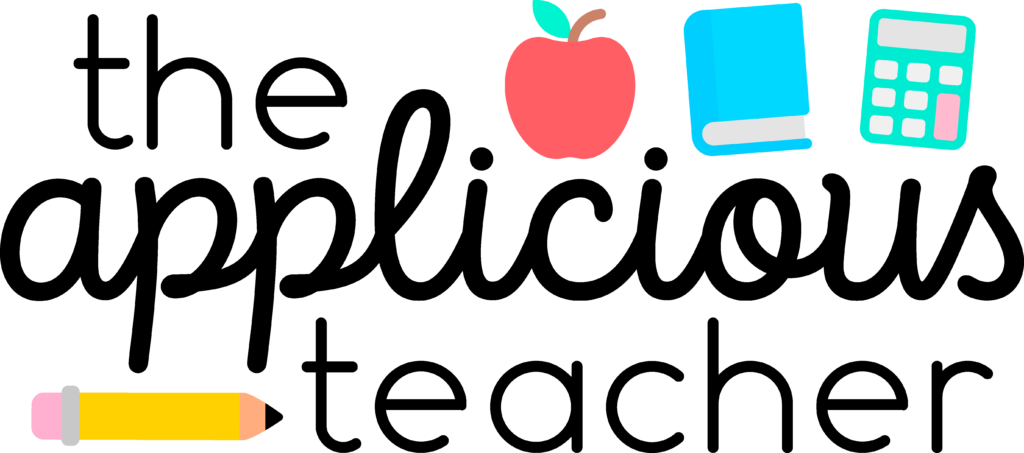
End the Unfinished Work Battle: Catch-Ups and Pickles
Share this post:.

Are your students struggling to complete their work? Up to your eyeballs in missing or unfinished work assignments? Then you might need to institute a “Catch-up and Pickles” routine in your classroom as a way to win the missing or incomplete work battle! This is seriously my favorite unfinished work routine!

A few weeks ago, I posted a Reel on Instagram about some of my more “controversial ” grading practices. Between you and me… they really aren’t that controversial… just good teaching! But folks LOST THEIR MINDS! And honestly, it shed light on a bigger problem: the struggle of incomplete work.
Controversial Grading Practices
You’re probably wondering what those controversial grading practices were. I’ll let you watch the IG Reel to see all three, but the one that had most teachers up in arms was the belief of not putting anything less than 50% in the grade book.
This one line led to me being called many things, but most teachers asked, “What about missing or incomplete work?”
To which I responded that I rarely struggled with incomplete or missing work. I can think of one time I had to put a zero in the grade book because of a missing assignment – ONCE – in 13 years of teaching. Those are some pretty good odds!

Unfinished Work Routine
So, how can this be?
First, let’s clear up some things:
- No – I didn’t have perfect students who completed every assignment without asking.
- No – I didn’t work at fancy schools with high volumes of parents involved who made sure the work was completed at home.
- And, no – I didn’t work myself to death chasing down students.
I rarely had missing or incomplete work because I planned time in my week for students to work on missing or incomplete assignments.
Today, I’m sharing this simple yet HIGHLY effective routine that basically eliminated the struggle to get students to complete missing or incomplete assignments.
This magical weekly routine that solves the missing work problem is fondly called, “ Catch-up and Pickles. ” But, that’s really just a fancy name for a time set aside on a Friday morning so students can work on unfinished work.
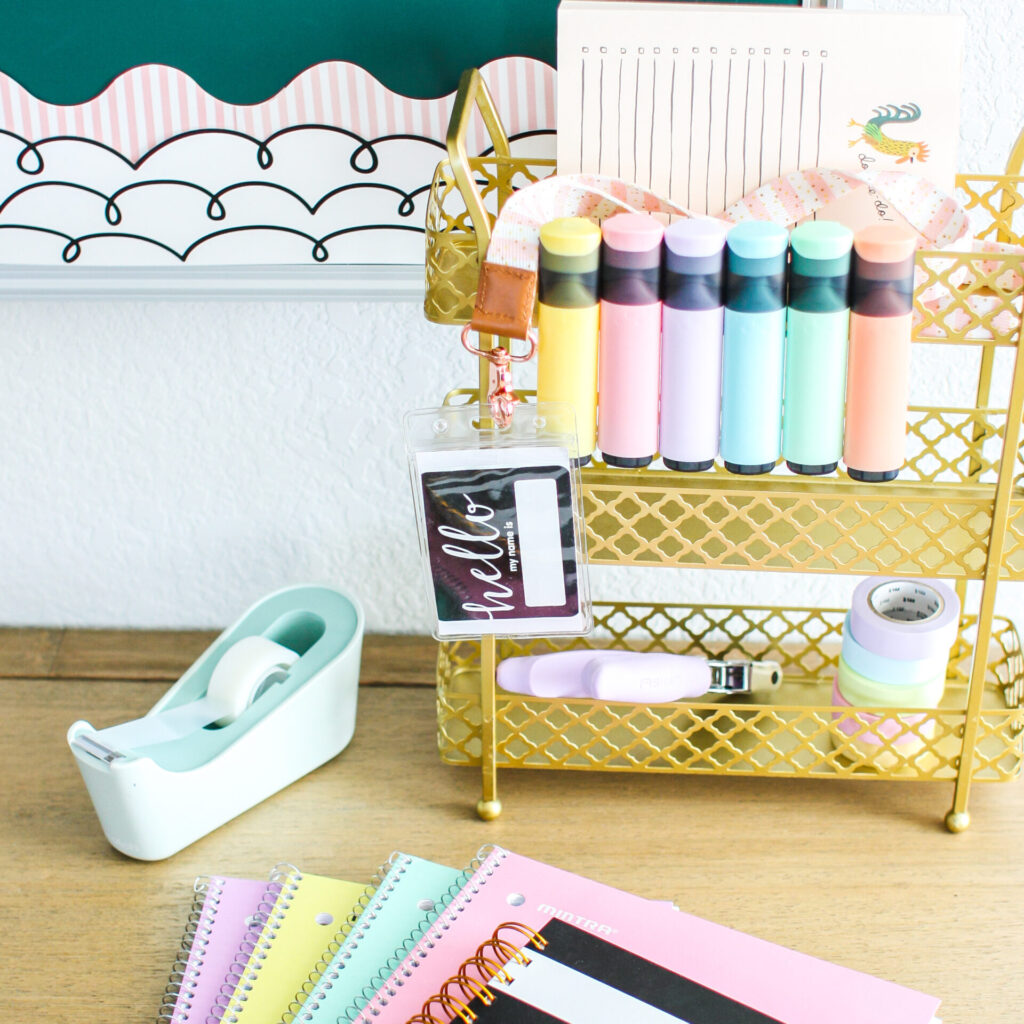
What is Catch-Up and Pickles?
I shared about this concept a while ago in my “Small Group Time Exposed” post , but I feel like after all the hoopla that Reel caused, it warranted its own place on the blog!
Each day, I had 60 minutes of time built into my schedule for small group rotations. That worked great Monday through Thursday. But, I noticed that Fridays were a bit cramped. Not only did we have our spelling and vocabulary test that day but we would also have a reading comprehension assessment. Time is needed to complete all these assessments, and that ate into a portion of our small group time.
Rather than try and stuff the small group instruction into the 30 minutes that were left after completing everything else, I decided to transform that awkward time slot into productive work time.
So at the end of the week, instead of formal center rotations, I did a “Catch-Ups and Pickles” routine. Students who had not finished their work used this time to “Catch-Up,” while those who were done were allowed to “Pickles” a reading-based activity to complete.
For students, this time was dedicated to completing their work or choosing a preferred activity to complete.
For the teacher, this routine provided time to reteach lessons, pull students for assessments , or conference with students one on one.
And let me just say… this was a wildly popular time in my classroom!
How to Find Time?
So the big question here is, how do you find the time? Everything you are required to teach in a day leaves very little time in your schedule for “makeup work,” but like I shared before… I was able to find time by reallocating the time I was using for reading centers. It wasn’t working for us on Fridays, so we changed it up.
I suggest you take a look at your schedule. Do you have some awkward or weird times?
I like the idea of doing Catch-up and Pickles on a Friday, so it’s easier to track the work that needs to be completed. But maybe Fridays don’t work for you. Look for a block of time (at least 20 mins!) and see if it works. If it doesn’t, restructure or choose a different time. This could even be something you do at the end of a unit in reading or math or on the last school day of the month.
Warning: I wouldn’t do this one day a quarter… that’s too big a chunk of time to complete everything. Doing that is like saving all your laundry for a month and trying to do it all in one day. Someone will get overwhelmed, and it’s not going to get done.
How to Get Started with Catch Up and Pickles
Once you’ve found your time, it’s time to plan the “Catch-Up and Pickles” activities.
In my classroom, I allowed students to “catch up” on any work, whether it be math, reading, or something else entirely. You need to select what students will be working on. Maybe it’s just reading, so you do only reading makeup work.
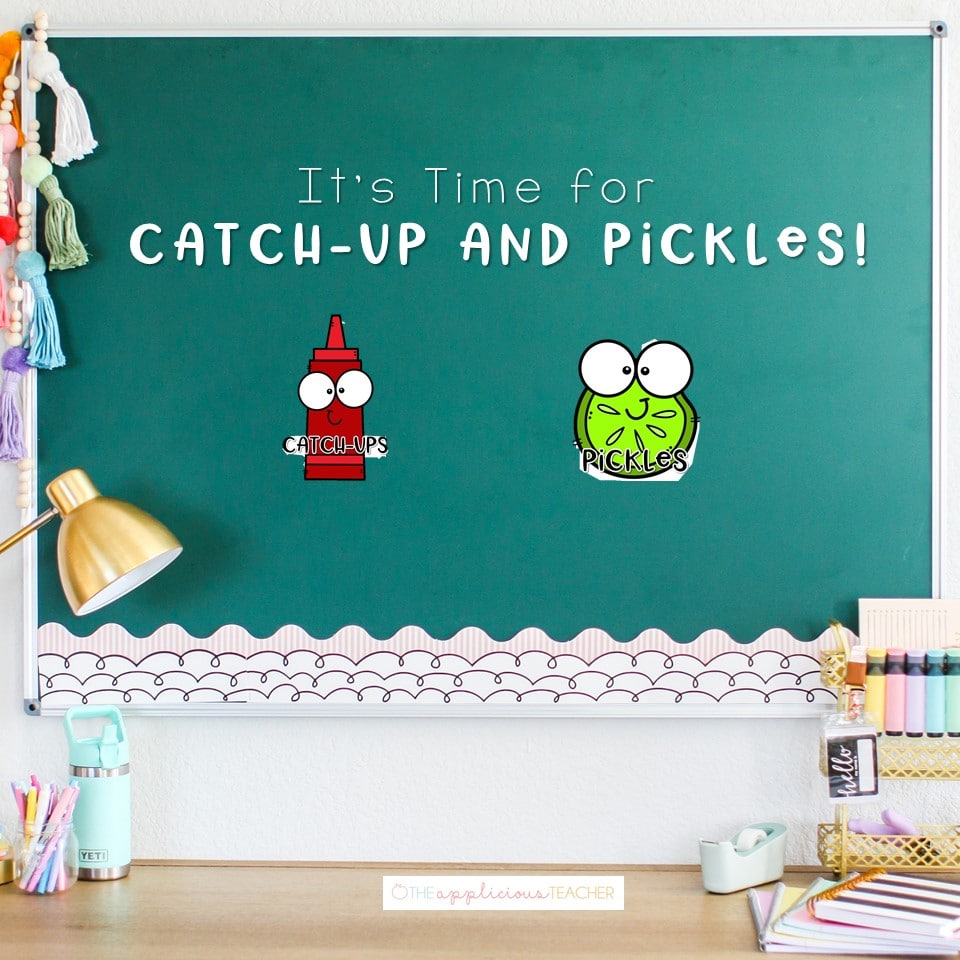
Whatever you decide, be specific. The unstructured nature of this routine means that chaos could happen at any minute. Being clear on what students should be working on at this time (and reinforcing it each time you have a Catch-up and Pickles session) can help keep the crazies at bay.
Who is a Catch-Up and Who is a Pickle?
From there, you’ll need a system for knowing who is a “catch-up” and who is a “pickle.”
Right before we started, I’d scan my grade book for any missing assignments. Those students with missing work would go on my “catch up” list.
Another way I identified students was through their “Unfinished Work” folder. Any classwork that didn’t get completed went in there (not tests or quizzes, just classwork). Right before we’d begin, students would pull out their folders and check to make sure there wasn’t any work that needed to be completed. If there was, they were on the “catch-up” list.
Let me just say, just even having an “Unfinished Work” folder helped a great deal with handling incomplete work! It was much easier for students to keep track of their work. If they finished an assignment early, they could either grab a book to read or work on unfinished work from their folder. The finished work folder lived in their desk, and I always told them, “If you aren’t done, put it in your finished work folder!”
You can read more about the unfinished work folder here !
I kept this routine real simple, guys! No fancy slide shows…just a whiteboard and names. In one column, I’d write “catch-up” with the students’ names and a list of work they needed to complete. In the other column, I’d write “Pickles” with the names of students who had completed all their work. When a student completed assignments and turned them in, they could erase their name and put it under the “pickles” side instead.
Activity Idea for Pickles
Now, remember, the name of any student who had completed all their work or their I-Ready minutes would be placed in the Pickles column.
My students loved being a pickle! They loved the idea of choosing their own activities (even if they were reading-based).
Some activities my students could pick from:
- Writing and illustrating stories – Pretty popular! Especially the illustrating. I showed students how to make a mini-book with lined paper folded and stapled together.
- Playing an educational computer game – Probably the most popular!
- Creating or playing on the IPad – Don’t worry, I was very clear about which apps they could use during this time!
- Completing a reading center game – Students could do this with their friends. I’d put any stations we had completed that week in an area towards the back of the classroom, and students could grab one to play. This also worked well for any student who needed to complete a station activity for their “catch-up” activity. Need reading center ideas? These were always a hit !
- Free choice reading – They could choose their own book and where they’d like to sit and read. They could also read with a buddy.
- Helping a friend complete their work – This one was pretty popular! I allowed it as long as they weren’t just telling their buddies the answers. Honestly, it was a win-win: The student got help, and the student helping was learning more! Bonus- it freed me up to complete DRAs, fluency checks, or reteach skills as needed.
- Teacher assistant – Sometimes I needed help, so if they were done and didn’t want to do one of the other activities, I’d put them to work, helping to organize papers or filling the mailboxes with returned work.
Unfinished Work Routine- Catch-up and Pickles
So there you have it, teacher friends. This is the simple, routine way I kept my students on top of their work. I mean, what teacher wants to feel like they are constantly chasing students around trying to get them to finish their work? NOT ME! Now you don’t have to!
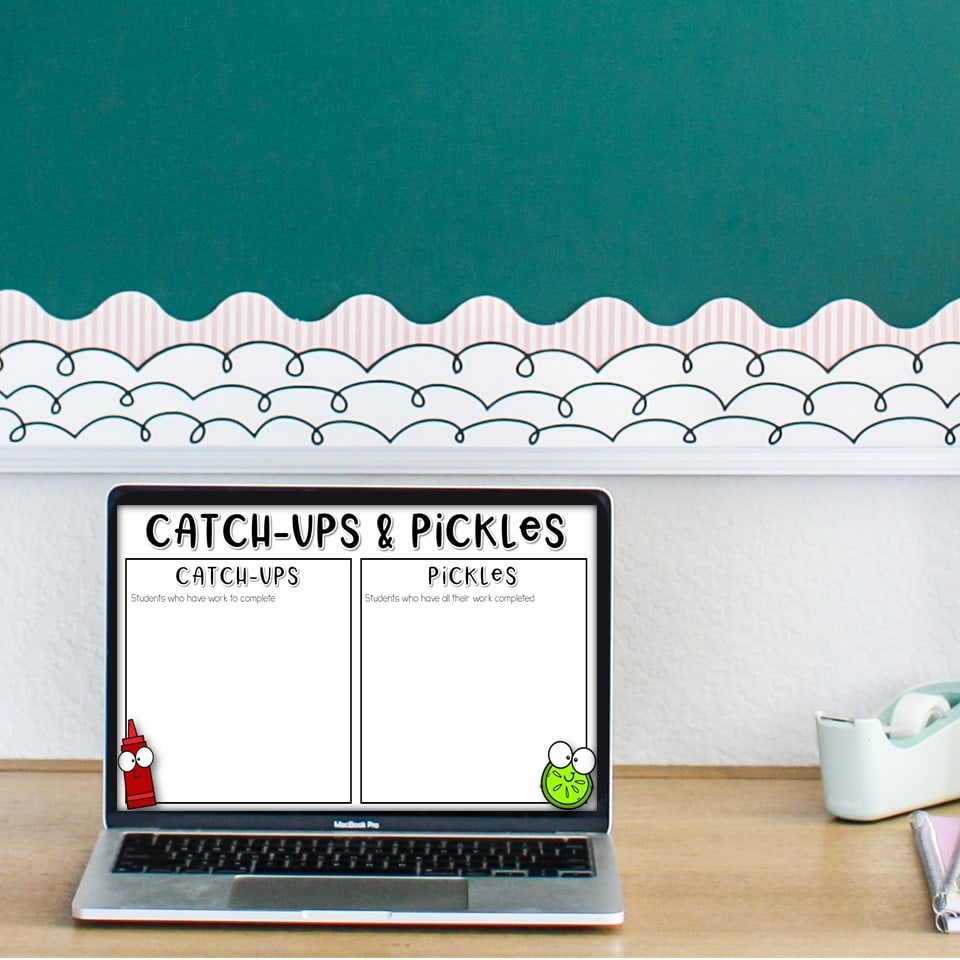
Free Catch Up and Pickles Download
Want to grab a few resources to help you get started? Click below and have this resource sent straight to your inbox! Now you can easily implement a Catch-up and Pickles routine in your classroom this week! This free download includes printable tracking sheets, whiteboard labels, and an editable PowerPoint file.

More Great Ideas!
Check out these other great ideas to try in your classroom!
- 5 Tips for Dealing with a Chatty Class
- How to Organize Your Google Classroom for 2nd Grade
- Help Students Take Ownership of Their Learning without a Data Notebook
- End of the Year Survival Tips
- Categories: Classroom , Classroom management

Hi, I'm Leigh.
The Applicious Teacher is all about creating hands-on and engaging lessons that align with the standards while still having time for your life. This is your place for ideas, tips, and resources for the REAL teacher!
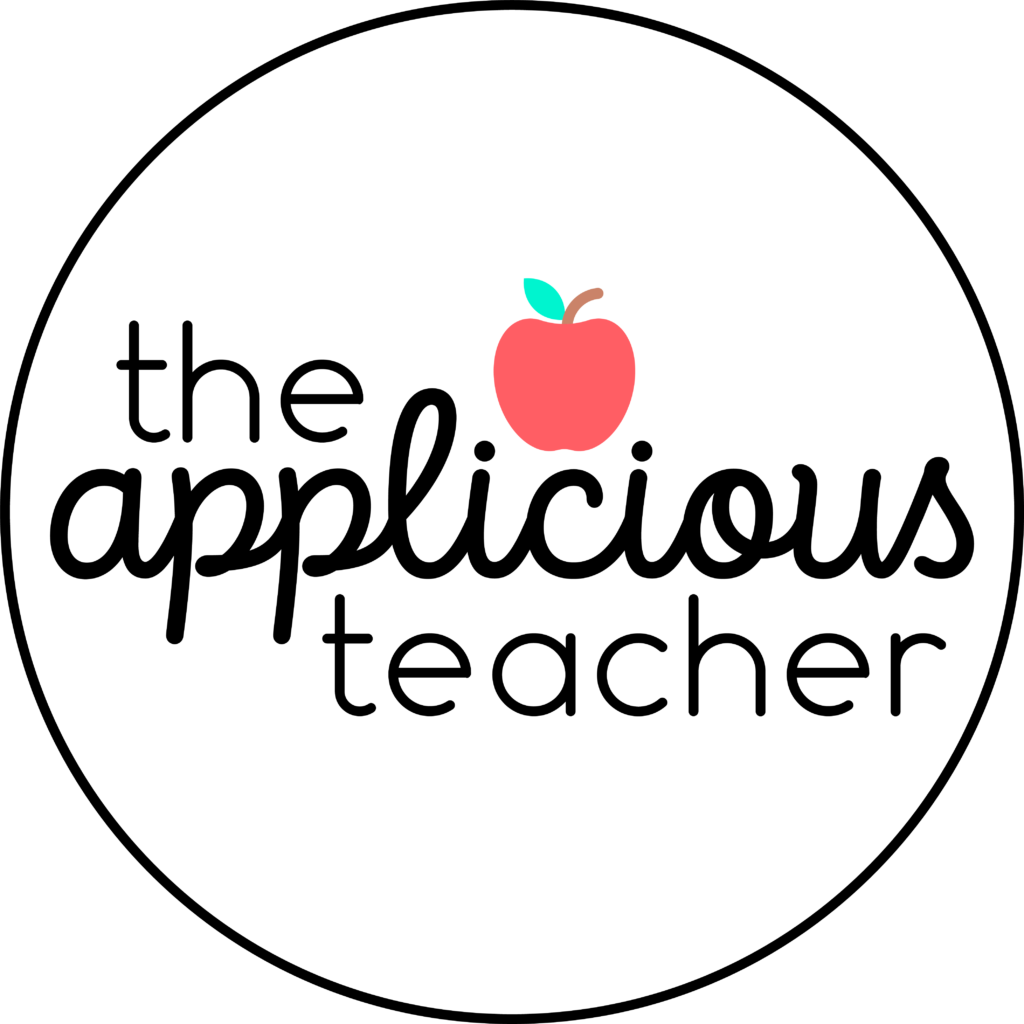
Recent Posts
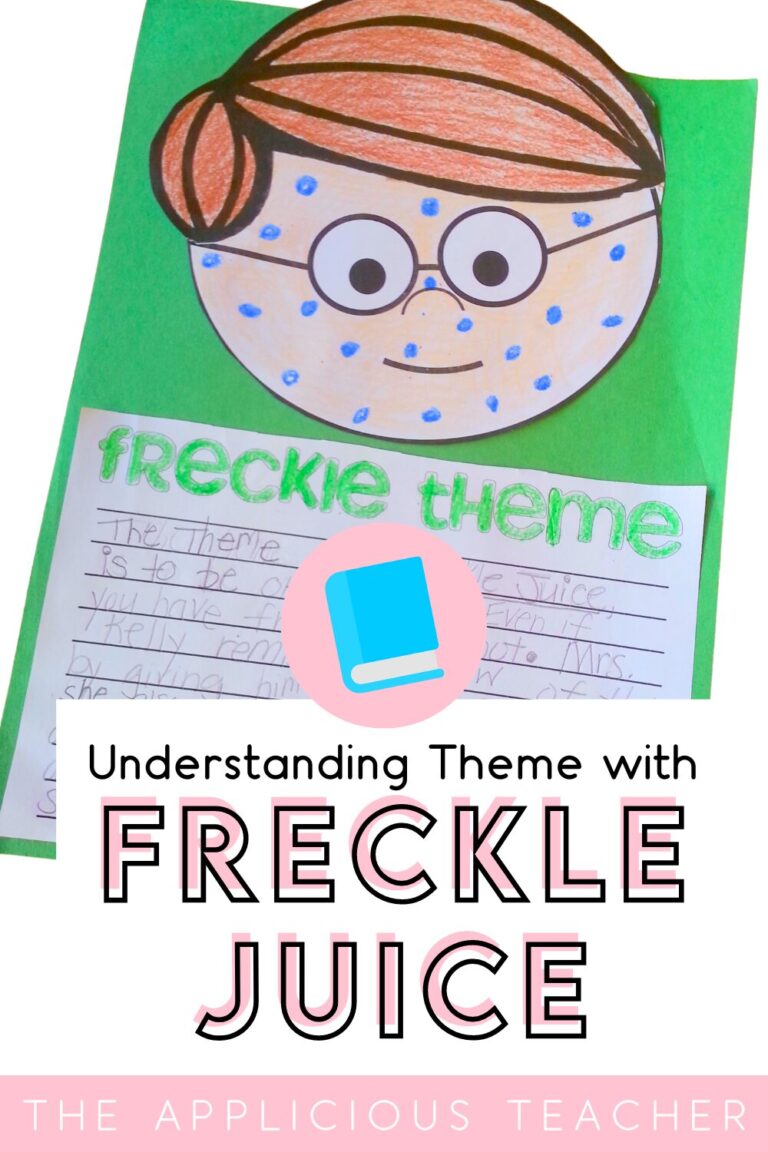
Popular in the Store
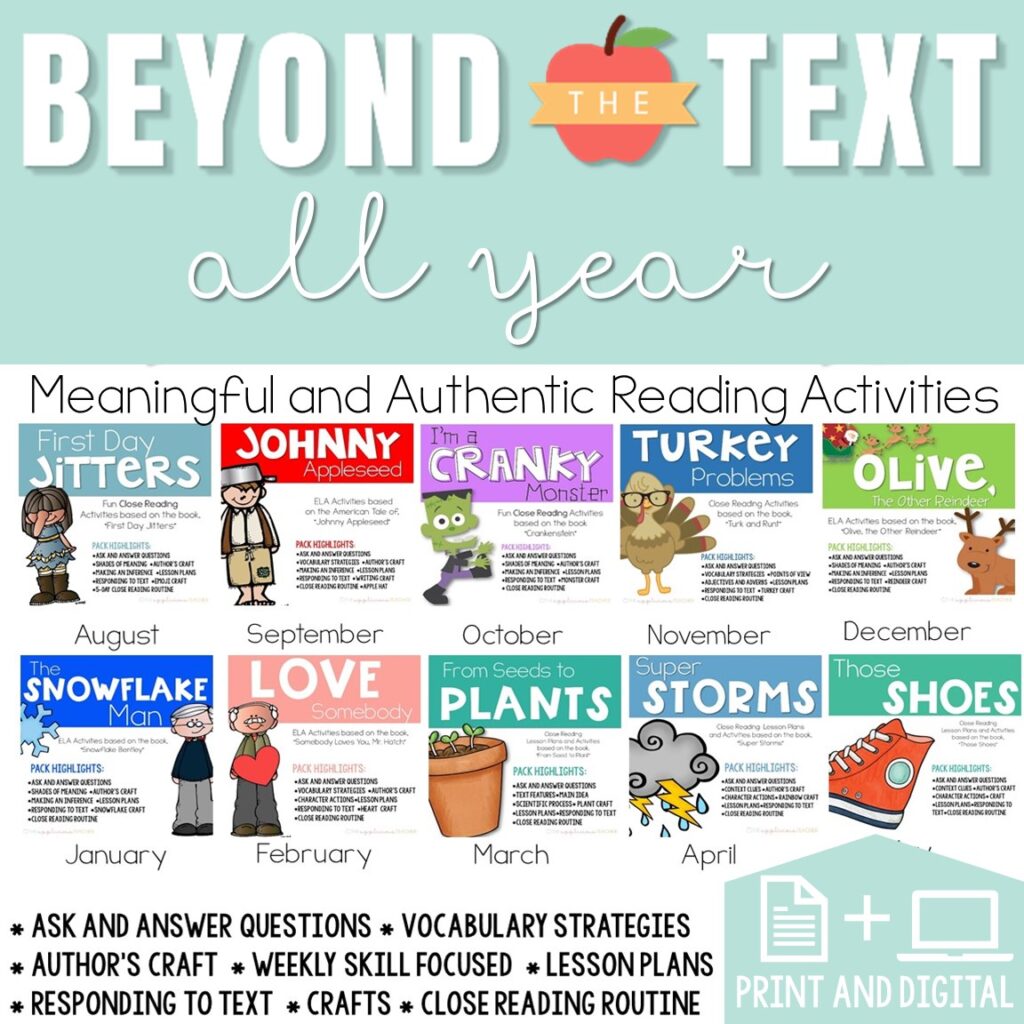
You may also enjoy...
Cinnamon ornaments for the classroom.

10 Reasons Why Teachers NEED Amazon Prime

Dental Health Activities Learning About Teeth in Kindergarten

Giveaway Winners and a New Year’s FREEBIE
© 2021 The Applicious Teacher. All Rights Reserved
Designed by Ashley Hughes
Use of Cookies
Privacy overview.
| Cookie | Duration | Description |
|---|---|---|
| cookielawinfo-checbox-analytics | 11 months | This cookie is set by GDPR Cookie Consent plugin. The cookie is used to store the user consent for the cookies in the category "Analytics". |
| cookielawinfo-checbox-functional | 11 months | The cookie is set by GDPR cookie consent to record the user consent for the cookies in the category "Functional". |
| cookielawinfo-checbox-others | 11 months | This cookie is set by GDPR Cookie Consent plugin. The cookie is used to store the user consent for the cookies in the category "Other. |
| cookielawinfo-checkbox-necessary | 11 months | This cookie is set by GDPR Cookie Consent plugin. The cookies is used to store the user consent for the cookies in the category "Necessary". |
| cookielawinfo-checkbox-performance | 11 months | This cookie is set by GDPR Cookie Consent plugin. The cookie is used to store the user consent for the cookies in the category "Performance". |
| viewed_cookie_policy | 11 months | The cookie is set by the GDPR Cookie Consent plugin and is used to store whether or not user has consented to the use of cookies. It does not store any personal data. |

Organizing Absent Work
Remembering to put out and collect absent student work can certainly be an extra thing teachers don’t always remember to do when they have 1,345 other items to worry about in any given school day.
So this is one of the classroom systems that is better when it has been thought about already and there’s a plan in place for managing the missed work and getting assignments back in a timely manner.

Any time I have something I know I will be doing more than once, I try to devise a system for it.
It helps to streamline classroom routines and helps me to remember whether I have done it or not – ha!
I remember as a new teacher sitting down to do grades my first time through and then promptly realizing how many grades I was missing because some students didn’t turn in their makeup work!
It was definitely my error in not following through, but I knew right away I was going to need a plan ASAP to remedy how I would keep track of students who were missing and how to get the work returned in a timely manner.
You might want to check out:

Need some new ideas for simple routines in your classroom? This 155 page digital book has you covered!
Includes 28 articles from Organized Classroom, including topics such as: • Classroom Jobs • Organizing Absent Work • Solutions for Constant Tattling • A Quick Idea for Student Engagement • Helping Student Get Organized • Remembering Names on Papers • Organizing All the Paperwork • Bathroom Break Tips …and even more!
Includes 10 additional freebie files! No need to enter in an email address for each one separately – just click and go!
See it HERE.
Best Makeup Work Folders
Some teachers prefer to have a folder with resources to manage the organization of the missing work. If it’s all in one spot, it’s much easier to keep track of. Especially if the folder is a bright color that is hard to miss.
Check out some different examples below:
A hanging wall file works perfect for filing all the extra handouts you have from the week.

How cute is this free editable custom work folder cover? Love it!

Another option is to place plastic pockets along the wall of the classroom, which have student numbers on them. This can serve for a great spot for an absent student to pick up his or her work upon returning.

A brightly colored laminated file folder works great for notifying parents of make up work.

Middle schoolers can have a makeup work area that’s always available for picking up their own work. A great way to teach student responsibility.

Adorable “ketchup” work folder!

Hang a folder on the back of each student desk. This can serve as a mailbox and a perfect spot to gather missing work to send home.

Assignment Sheet Slips to Track Missing Work
Need a worksheet to make sure the student’s work is all together and has been documented? Check out some good options I have found in various places.
A super straightforward option to use where you write in the missing assignment.

A spot for everything, including what was done during group teaching lessons.

Love how this folder cover even has a date that the work needs to be returned. Makes it easier for caregivers to know when it’s due as well.

A snap to fill in and a snap for students to understand what was done in each class.

This pdf is a little more involved, but definitely gives a clear view of everything that was covered on the day that was missed.

Lots of learning reminders on this form too…

Would you like to know step-by-step routines that put teachers back in control in just 4 weeks?
Download the FREE Classroom Systems Starter Kit now!
More Strategies for Managing Assignments from Absent Students
And today, we have a BONUS! Earlier in the morning, I noticed another topic that took off on it’s own on our Facebook Page .
From a fellow fan Tina: “ Help! I have been teaching 11 years and still have not found a fool proof way to get work out to students who have been absent and DOCUMENT that they have received it so that they don’t come back later and say they never got it… AND get it back in a timely manner… Any suggestions? “
Well, in true OC Blog style, the fans came through once again and gave Tina all sorts of suggestions!
In particular, I like to use a folder to place the absent work in as I am passing out papers throughout the day so I don’t forget. I have even been known to just place the Absent Folder on the missing child’s desk and have someone sitting nearby place the papers in the folder as they are being handed out. At the end of the Bonus e-book, I created a simple template if you wish to do the same.
Grab yours below!

What are your best tips for managing absent student work? We would love to hear them in the comments below!

Similar Posts

How Do You Balance Home and Work Life?

Classroom Library Solutions

Motivating Your Student Writers

Remembering to Write Your Name on Your Paper

Proactive Teachers vs Reactive Teachers

Curriculum Mapping Your Content
Leave a reply cancel reply.
Your email address will not be published. Required fields are marked *
Save my name, email, and website in this browser for the next time I comment.
- Student Data Platform
- - Data Dashboards
- - Data Warehousing
- - Data Integrations
- Advisory Services
- Strategic Decision-Making
- Progress Monitoring
- Family Engagement
- Public Dashboards
- Interactive Demo
- Why Schoolytics
- Resource Hub

Tracking Missing Assignments For Students and Guardians
Published: April 18, 2023
As the end of the school year approaches, students need to get their missing assignments turned in. Not only does this help their overall grade—most class grades depend in part on assignment completion and grades—but completing more assignments helps students’ comprehension as well. Sure, some homework is “busy work”, but certainly not all.
We talk a lot at Schoolytics about how teachers can handle missing assignments , including how to engage parents in their communications around missing work.
But the student and family side is just as important, if not more so. Indeed, teachers only have so much influence over what students do between 3pm and 8am.
Gaps in the student experience in Google Classroom
Students can see their missing assignments in Google Classroom. Helpfully, missing assignments from all classes are listed.
However, the lack of search functionality (“Didn’t I have an assignment about the Pythagorean Theorem that I missed while I was out sick?”) is a real barrier to finding assignments to work on. The inability to sort by anything other than date is too restrictive. This constraint, combined with the groupings for “This week”, “Last week”, and “Earlier”, makes the missing assignments view clunky.
In addition, the “View all” expansion button is easily missed, especially for parents who are not familiar with the interface, leading some students to incorrectly conclude that they have only five missing assignments.
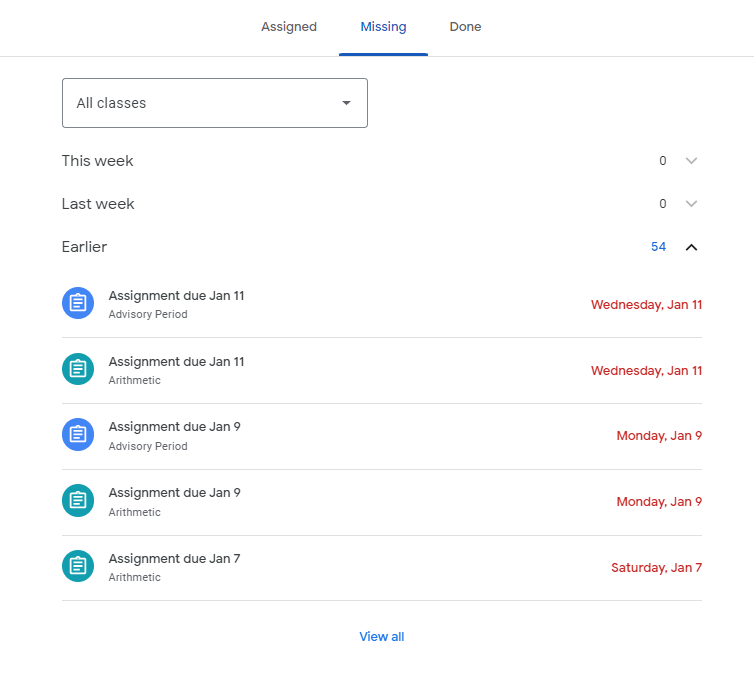
What students really need is support with time management and prioritization skills (all part of executive functioning ). This manifests as understanding how to choose which missing work to tackle first and why. When faced with dozens of missing assignments, where do you start?
Perhaps they want to do assignments that are worth a lot of points. Perhaps they need to ignore assignments due before a specific date because their teacher stopped accepting late work. Unfortunately, these filtering and sorting aids are not available in Google Classroom.
But students can get very granular with missing assignments in Schoolytics . Sorting, filtering, and ranking are all possible.
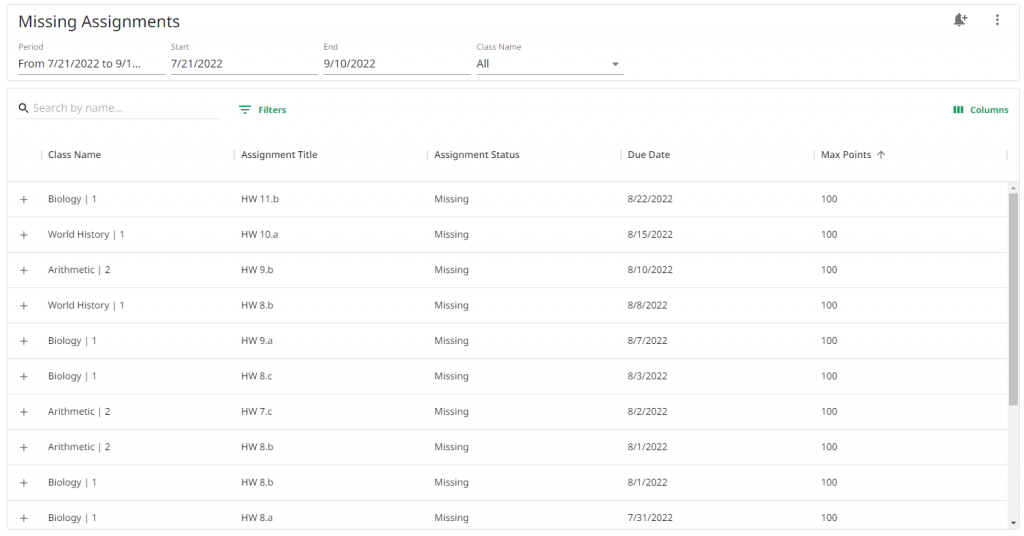
In addition, Schoolytics gives students insights into their aggregate data, so they can see how they’re faring more generally. This also helps them to see more clearly how they are progressing across all of their classes, and prioritize their time accordingly.

Options for Guardians
Because Google Classroom lacks a robust parent experience , guardians have additional challenges in tracking missing assignments for their children. The guardian summaries are somewhat helpful, but are not clickable and only give parents a brief snapshot into what was missed over a period of time. There needs to be a summary of the severity of the problem. Parents tend to ignore them for lack of actionable information.
In Schoolytics, we focus on summarizing and distilling the information down so that guardians can know at a glance whether their child is significantly behind or just has a few things to hand in. And they can see all of their children in one view, thereby saving a lot of time trying to log in and out of Google Classroom accounts. Parents can set alerts, which are similar to summary emails, to keep tabs on missing work.
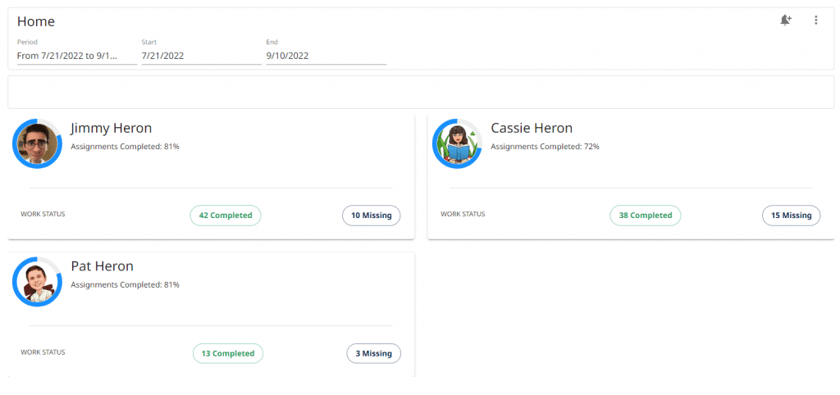
Thousands of parents, guardians, students, and educators use Schoolytics to unlock a deeper understanding of missing assignments. Want to learn more or share Schoolytics with your district? Get in touch with us today!
Related Articles
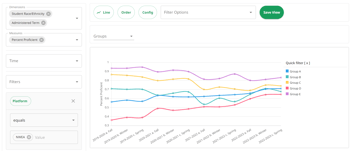
Why Tableau and Other Traditional BI Tools Are Ineffective for K12 School Districts
Is Tableau Really Worth the Cost? Exploring Cost and Effectiveness of BI Tools for K12 School...

Maintaining Your School's Data Amid Staff Turnover

A Better Way to Handle Missing Assignments

- Remote/Hybrid Teaching , Technology in the Classroom
My Favorite Way to Manage Students’ Missing Work
For me, trying to manage students’ missing work used to be such a headache! It was so much work to keep my lists up-to-date and get current information to students.
I tried so many systems, and regardless of what I did, I found myself drowning in small sheets of paper. It took more time for me to track down missing assignments than it took for the students to complete the work.

I guess it took remote and hybrid teaching to help me finally get down an effective system.
First, I created a sheet in Google Sheets™ to record the assignments I assigned each day. Each week, I created a new tab and labeled it with the date. I checked off work once it was turned in, changed the box to red if the assignment was missing, and changed the box to blue if the assignment needed a second look.
Now that it was easy for me to see who completed a given assignment, who was missing it, and who needed a second look, I needed a system of communicating that with the students. I also wanted to make sure this information was available to parents.
Using Google Docs™ allowed this information to be easily shared
I created a separate Google Doc™ for each of my students with each of their names, brief instructions, and the list of what they were missing. Using the share button, I changed the permissions so that students, their parents/guardians, and support teachers were able to edit and view the document. This allowed everyone to have up-to-date information regarding students’ outstanding assignments.

So I didn’t have to go back into each missing work page to update as students completed their work, I allowed students editing access. They delete the assignments off their list after they complete them. A few students tried deleting their assignments off the list without completing them. For students who made this a repetitive habit, I changed the settings to comment only which allowed them to inform me what was finished without actually deleting their on-going list.
Initially, it did take a bit to set up each of my students’ pages. However, now that it is done, I can quickly update my students’ pages. I created a bookmark folder on my taskbar called Missing Work. Within that folder, I have each individual page. I just need to click on that folder to access the missing work pages. Compared to handwriting, erasing, searching, forgetting to update, and writing again that happened with my previous systems, Google Doc missing work pages are saving me tons of time.
Why I LOVE this system:
- Students are responsible for checking their missing work page and managing it themselves by deleting what they complete
- Parents have easy access to see if their child is missing work and help support him/her at home
- When I email parents about missing work, it is easy to reattach this page for the information
- Teaching assistants or other staff members can help support my students complete their work, too
- I don’t have to continually rewrite missing work notes
- All the information is in one place—say goodbye to little notes everywhere
- Students just need to click the hyperlink to find their assignments
Let me know if you try this system! I would love to hear about it.
Happy Teaching!
Julie from Llama with Class
Grab some freebies to help you manage students’ missing work with this system
You will need a Google account in order to get these freebies. Click each picture to force a copy to your Google Drive™

You might also like...
Student growth during the pandemic, find what you need, make every teaching moment count.

- About Katie
- Application Essays
- The Journal
- Join Thousands on My List

How to keep track of homework assignments
Katie Azevedo December 29, 2016 good habits , homework , productivity , study skills , time management
The first step to getting a good grade on an assignment is to … wait for it … do the assignment!
Simple, right?
Maybe, but only if you remember to do the assignment. For some students, knowing how to keep track of assignments and their due dates is a huge challenge. Here, I’m going to explain how to keep track of assignments and projects, and give you some tips for staying organized. A cool angle to this is that what I’m going to be talking about is completely applicable outside of school. So if you’re not a student, but you still have due dates and project deadlines – pretty much like any human – then this system is for you, too.
1. Find a planner system and use it multiple times every day.
The KEY step for keeping track of homework, which I’ll get to next , is to write everything down. But before that happens, you need a place to write it all. You have three options here. 1) paper 2) digital 3) a combination of both. Personally, I use a combination of both. While I am a pen and paper person at heart, I do use Google calendar in addition to my paper calendar. I have a family and a business to run, so I need the digital aspect to be able to share calendars with other people. For my paper calendar I use the Staples Arc system . It’s cheap, simple, and super customizable.
I advise you to pick a system based on what’s convenient and easy, and not on what is cool. There are a gazillion list apps out there with fancy features — some of you may have heard of Evernote , the king of task management apps — but the goal is to keep it simple and use a system that you don’t have to stress about. If it’s too complicated, you won’t want to be bothered to even take it out when you need it. Whatever you pick, be sure it includes a monthly calendar and a daily calendar/agenda. Here’s why:
A monthly calendar allows you to see, at a glance, what assignments and appointments are coming up over the next few days or weeks or months. It’s key for long-term planning.
A daily calendar/agenda allows you to see and plan for what’s coming up tomorrow and in the very near future.
Whether you go for a dated calendar or an undated one (one you have to date yourself) is up to you. What size is up to you. (I use a half-sized one and a full-sized one!) Here’s a picture:

The cover and paper inside your planner is up to you. Whether you color-code your entries is up to you. (I do!) Make it something you’re excited to use, while keeping it simple.
It’s important to use your system multiple times a day because the more you use it, the more you trust it. And the more you trust it, the more it will work.
I’ve heard so many students say “I’ve tried using an assignment notebook and calendar, but it doesn’t work.” But when I ask them if they write everything down, they say no. And that’s why. So you’ve got to commit to your system. Use it multiple times every day. Get in the habit of checking it every morning or every night before bed so you know what’s on your agenda.
2. Write everything down. And the operative word here is EVERYTHING.
I have a theory that I’ve lived by for the longest time: Our brains weren’t made for storing information, but are instead made for creating and processing information. (Lol … it turns out that I’m not a genius and that I didn’t invent this theory.) Several scientific studies actually support the idea that to a degree we have a maximum brain capacity. And if we use up all that capacity for storing information and trying to remember everything … then there will be no brain energy left to create, think and process. So by writing things down, we get them out of our heads, which frees up space for us to be smarter and more creative.
Plus, there is just no way on earth that we can remember every little detail of what’s due when, as well as the time and date of your next doctor’s appointment. If something comes up and you’re not sure whether to write it down, write it down!
Here’s what you should be keeping track of:
- Daily homework assignments (short-term)
- Project due dates (long-term)
- Upcoming tests/quizzes
- Books that have to be read by a certain point
- Appointments (doctor, dentist, guidance counselor, coach, etc.)
- Things you’re supposed to remember to do (ie: talk to math teacher)
- After-school activities, sports (even if you have practice every day from 2:30-5, block out that time on your calendar)
- Weekend activities
Here’s another important tip: write assignments down the moment their assigned, and write appointments down the moment their scheduled. Do NOT tell yourself that you’ll remember to write it down later. Doesn’t work! Plus – that defeats the purpose: you don’t want to use your brain to remember . If you don’t have your paper agenda with you when something comes up, then set a reminder in your phone to write it down later, or write the assignment down on a sticky note and put it somewhere you won’t forget. Then, transfer the information into your planner the moment you get home.
3. Set up reminders.
Let’s say you have a project due in one week, so you write down “biology project due” on your calendar on the date it’s due. Sound good? No! No, because you don’t want to end up checking your calendar on the project’s due date and realizing “Oh crap! It’s due today!” So the hack for remembering to do the assignments you write down is this: remind yourself along the way.
You can do this several ways, depending on your system. If you’re using digital, like a phone, use the default reminder app to remind yourself of the project at least a few days before it’s due. You can even set up several reminders throughout the week. If you’re using a good old paper calendar, then in addition to writing down “project due” on the actual due date, write in several reminders to work on the project on the days leading up to the due date.
A reminder system also helps you manage your time for long-term assignments because it encourages you to work a little bit each day towards the larger goal.
4. Keep your planner/calendar accurate and up-to-date.
Your homework management system is only going to work if it’s accurate. So you’ve got to be sure that you update your calendar and your agenda as things change. So if your teacher gives an extension or changes the due date of a project, or if your band concert or meeting is rescheduled, make those edits in your calendar. (Try to keep it neat if you’re using a paper system, so that might mean using whiteout. Messy on paper equals messy in the head.) And remember the rule: make these changes immediately if possible.
If you end up using a combination of a digital system and a paper system, make sure you sync the two systems daily. I have run into the problem where I’ve added an appointment in my phone, but then forgot to add it to my paper calendar, and then I totally forgot about it. Oops! So I make it a habit to review both calendars/agendas every night to make sure they both contain the same information.
How to keep track of homework assignments: Extra tip
There are going to be times when you fall off the bandwagon and let your system slip. You might go a few days or even a week without writing things down – either because you forget or you keep telling yourself that you’ll do it later. But don’t give up on your system. Just pick up where you left off and get back to writing down every little detail. Whenever you wander away from your system, bring yourself back to it, and don’t judge yourself.
Also, these moments can be learning opportunities! Whenever you stop using your agenda or calendar, ask yourself why? Why did you stop? What part of the system wasn’t working? If the system was easy enough to use, you wouldn’t have stopped. Is your notebook so big that it’s annoying to bring with you? Then get a smaller one. Are you not writing assignments down because you don’t have enough space in the “Daily Agenda” part of your notebook? Then get a notebook that gives you more room to write down your daily tasks. Did you think you were a techie, but find the app stuff too complicated? Or vice versa? Then switch systems. Modify as you go. You won’t come up with the perfect system right away, but you will instead figure out what works for you as you go. Be open to change.
So those are my 4 strategies for how to keep track of homework assignments. If you have some strategies of your own, then please share them in the comments below!
Subscribe to ReportCard Newsletter!
Get your FREE download of 25 School Habits and Hacks when you sign up for our monthly newsletter featuring awesome school tricks and tips
I will never give away, trade or sell your email address. You can unsubscribe at any time.
The Pathway 2 Success
Solutions for Social Emotional Learning & Executive Functioning
40+ Strategies and Supports for Students Who Are Failing Class
October 17, 2023 by pathway2success Leave a Comment

Sometimes, kids and teens struggle in keeping their grades up. With enough struggle, students can end up failing a class (or just be in danger of failing). This can be for a multitude of reasons from being absent too many times to not understanding the concepts to not turning in assignments. Regardless of the reasons, when kids and teens are failing a class, it’s a big problem. The good news is that there are strategies and interventions to help kid and teens get back on track.
We all play a role. An important note to mention about this article is that I have divided it up into three sections of strategies. These are strategies for the student, the educators, and the parents. There are so many strategies that they could be split up into three separate articles, but I purposefully kept them together. That’s because while it is ultimately up to a student to do the work required to pass a class, we all play a role in setting the stage, providing supports, and helping them get back on track. We’re in this together.

One more idea to keep in mind is that kids who are failing might feel like they are too far down the road to make their way back to a passing grade. Sometimes, it can feel hopeless for them. They need to know that adults are there to help them and that they can use strategies to help themselves too.
EDUCATOR STRATEGIES
Consider the underlying reason why a student might be failing. There are many reasons why a student might be failing a class. Finding the underlying reason can help get to the root of the problem. Is the student refusing to do work because they are struggling with some personal challenges? Is the student having trouble keeping ahead because they are juggling too many after school activities? Is the student not preparing enough for tests and quizzes? Sometimes, this isn’t always easy to find out, but it’s worth investigating.
Collaborate with other educators. Talk with other educators and compare how the student is doing in other classes. Is the student failing in just one class or across the board? Understanding this can set the stage for next steps.
Provide encouragement. Remind the student that they can improve their situation with hard work and strategies. It’s important to keep a supportive mindset with the student, since the goal is to empower them to make better choices.

Meet privately with the student. Talking 1:1 with the student in a private setting can have an impact. If possible, meet privately with the student by calling them out of study hall or homeroom for a short session. Use this time to identify the problem, discuss, and come up with potential strategies together. It’s important be open to listening to the student’s perspective. Sometimes, the problems and solutions they list can be extremely helpful information.
Provide a list of missing work. After talking with the student, provide a concrete list of assignments they can make up for full or partial credit. Creating a missing work list serves for a few different purposes. For one, it lets the student know exactly what they can do to get started improving their grade. Also, the list can be mailed home and sent to administration for record-keeping at the same time.
Teach executive functioning skills. So often, students are expected to plan, stay organized, manage their time and work through challenges. When students struggle with these skills, it greatly impacts their ability to perform well in classes. The good news is that young adults can learn and apply meaningful strategies to help them. Use lessons and activities to teach executive functioning skills to give students the foundational skills they need.

Involve school administrators. When a student is in danger of failing, it’s important to be open and share this early on with school administrators. This is for a few reasons. First, the administrator can step in and contact families to provide an extra layer of support and reminders. Also, it’s important for the administrator to know early on that you are implementing strategies and supports. There should be no surprises about a student failing a class, which is why it helps to involve admin early on.
Give a study hall check-in. Stop into the student’s study hall or resource room to give an extra check-in. Sometimes, a study hall time for kids can be overwhelming; they have so much work and they’re not sure exactly where to start. When you give a check in, be specific about what work they can do in that moment to help get back on the right track. The goal is to help them get started and then allow them to complete it independently. This also helps model healthy work habits.

Teach SEL skills directly. Many social-emotional skills are actually a prerequisite to success in the classroom. These include skills like working with others, managing emotions, problem-solving, and persevering through challenges. Consider teaching social-emotional skills to your student (or whole class) to provide a foundation of support.
Consider learning challenges and needs. It’s important to consider if a student may have learning challenges that may have gone previously unnoticed. How are the students’ reading, math, and writing skills? Do they need interventions and tutoring in school? Do you suspect the student has a learning disability? If so, these are important questions to bring up and discuss with your school team.
Provide a daily check-in. A quick check-in with a student can help them feel connected while also building accountability. Every student check-in might be a little different depending on what that student needs; some students might need an emotion check in while others might need a check of their homework log. Some students might need both to help them do and feel their best. This check-in can be implemented by many different educators depending on what works in schedules, from a school counselor, classroom teacher, or paraeducator.

Consider social-emotional challenges and needs. Consider if the student has unmet social-emotional needs. It goes without saying that sometimes social-emotional challenges can impact academic challenges in a huge way. Touch base with your school counselor or school social worker to discuss supports that can be given, such as a group or individual counseling time.
Continue building a relationship. Many times, kids and teens need to feel connected to fully open up about their challenges. Continue focusing on relationship-building strategies . This isn’t a quick-fix but it’s a necessary support along the way.
Build motivation together. When conferencing or meeting with your student, discuss what it means to be motivated. Brainstorm strategies to build motivation together. You can even use motivation workbook activities to help build strategies for getting started, staying focused, and meeting goals.

Contact families. Work with families early on to let them know their child is struggling. Sometimes, these conversations can be uncomfortable, so it’s important to be open, honest, and supportive.
Build organization skills. Being disorganized can severely impact a student’s success in the classroom. If this is an area of need for your student, consider giving extra support specifically with organization skills. This includes teaching how to use a planner, keeping binders in order, and having the right materials each day. If this isn’t something that can be directly taught during class time, it might be worth reaching out to the school counselor or school tutor to see if they can work on some of these skills with your student.

Encourage healthy homework habits to families. From setting up a homework spot to keeping electronics away, encourage some homework habits for success that can help your student.
Schedule a family conference. A face-to-face conference with families and the student themselves is important. This sets the tone that extra supports are needed. It may help to ask an administrator to be present at the meeting too. One important note here is that the student should join the meeting too.
Develop a guided study hall. A study hall is often unstructured independent time to work. While this is great for self-starting students, it can be a struggle for those who need more direction. Consider implementing a guided study hall. This time is a more structured small group of students who need extra support. It should be run by a teacher or paraeducator who can give extra reminders and strategies along the way. For example, a 7th grade guided study hall might have a list of today’s homework up on the board. That teacher can get kids started on an assignment and provide academic support, as needed.

Develop a contract with the student. A contract very clearly spells out all the expectations for the student. Outline what the student is responsible for. For example, you might write in that the student will complete daily homework each night and will review grades with their homeroom teacher on Friday. Add in other interventions from the school. Then, have all parties sign the contract.
Teach study skills. Some students do not know how to study for tests, write down homework, or prioritize their work. These are skills that are essential for success in the classroom. Use strategies to teach study skills to help students do their best.

Try peer tutoring. Peer tutoring is a research-based practice that can teach both the tutor and the student they are teaching. If your school doesn’t currently support peer tutoring, it is something to be creative with and consider. For example, your peer tutor could earn extra credit for helping during study hall.
Consider extra credit opportunities. Sometimes, extra credit can be a helpful option. Such assignments can serve to help a student improve their grade, boost confidence, and teach meaningful skills. Ultimately, this is a decision up to every individual teacher to decide what works best for them and their learners.
STUDENT STRATEGIES
Start with a growth mindset. A growth mindset means knowing that you can improve your skills with hard work and dedication. At first, failing a class might feel like an impossible-to-fix situation, but it’s often not. You can learn and implement strategies to help yourself make better choices and improve your grades.
Check your grades. Being aware is one of the first steps to helping you get back on track. Review your grades to figure out where you currently stand. You can write these down to chart them over time.
Talk to your teacher. Show responsibility by asking to meet with your teacher to work on your grade. Use this time to talk about your current grade and ask for suggestions on how to improve it. It also helps to come prepared with your own suggestions to show you truly want to improve.
Plan a dedicated daily homework time. Habits make it all happen. Start with a dedication daily time to work on homework assignments and study for assessments. Some students might do best working right away after school is over. Others might work best an hour after they get home to help them unwind from the day. Choose what works for you and stick with it.

Make a goal for yourself. Setting goals helps us accomplish tasks. Consider a measurable goal that you want to meet, such as getting a 70% or higher in math by the end of the quarter. Then, list out steps to get there. Check back in with your goal each week to make sure you’re on track. Consider meeting with an adult at home or at school to help you with writing this goal, if needed.
Keep up with current work. From this point forward, make sure you are staying on track with current assignments. Missing more work will set you further behind, so it’s important to stay up-to-date.
Make a missing assignment list. First, check to make sure your teacher will accept late work. Then, make a list of all the assignments you can turn in for credit. Try to not get overwhelmed with the amount of work if you have many missing assignments. Just get started on a few and turn those in to get some momentum.
Get organized. Being organized can help you accomplish tasks. Spend time tidying up your binders, backpack, and workspace. Then, tackle them on a regular basis to stay organized.
Use a homework log. Use a daily homework journal to record assignments. Some students prefer a paper notebook while others do well with a digital app. Find what works for you! Whatever you choose, make it a habit and consistently write in your assignments.
Participate in class. Make an effort to stay engaged in classroom learning by participating. One way to do this is to take notes while the teacher is teaching. These notes can help you later on when you need to study or review. Another strategy is to raise your hand to answer questions and share ideas. These strategies will help show your teacher that you are invested in learning.

Study with a friend. For whatever class you are struggling in, find a friend who can study with you.
Talk with a school counselor. A school counselor can help you with many things, from personal challenges you’re going through to making a plan to talk to a teacher about your grade. Consider signing up for time with your school counselor to work through some of those needs.
Ask for extra help. Asking for help is a strength! Consider reaching out to the classroom teacher and seeing if there is any extra help available. Be willing to stay after, come during your study hall, or even visit during lunch if that is what is needed.

Know when to put distractions away. This is a tough subject, but an important one! Phones and other digital devices can be extremely distraction during work and learning sessions. Know when you need to put them away to help you focus and accomplish tasks.
Be open to learn new study strategies. If you struggle with tests and quizzes, be open-minded to try new study strategies. Consider quizzing a friend back-and-forth with questions. Make flash cards. Make a mock test and quiz yourself with it. There are many different study strategies and habits to try.

Find an accountability partner. Ask a friend or trusted adult to help hold you accountable for doing your work and studying for tests. Just talking to someone about your progress and goals can help you develop greater self-awareness.
Get enough sleep. Getting enough sleep at night is important to help you doing and feeling your best. Consider coming up with a plan to get enough uninterrupted rest at night.
PARENT STRATEGIES
Provide encouragement. Be a positive force to help your child turn their grade around. Remember that your child may feel it is impossible to recover from their failing grade, making them want to give up entirely. Remind them that they can turn it around with support, strategies, and hard work.
Help your child cope with stress. Failing a class is a stressful situation for young adults. Sometimes, before we solve problems, we have to cope with the emotions first. Help your child build healthy coping strategies to manage stress with activities like deep breathing, listening to music, and mindful coloring.
Check grades together on a regular, planned basis. Checking through grades together helps holds students accountable. Plan a weekly time to review and stick with the schedule.

Create a dedicated work space. Set up an area where your child can complete their homework and studying each night. Set up some rules and expectations for the work space, such as no TV or cell phones while working at the space.
Check over the homework together. Before your child starts their homework , sit with them and review the homework for the night together. This provides an extra layer of accountability and structure.
Chat with the teacher directly. If a teacher hasn’t reached out to you personally, send an email or phone call to get in touch and discuss. Work together to come up with some actionable steps. If your child is continuing to fail, ask for an in-person meeting to discuss strategies.
Schedule consistent work session time. Habits make all the difference! Agree on a daily work session time each day for homework, studying, and organization. Then, put your plan in action.
Complete work together. Try sitting down with your child as they complete their work. Help them get organized and set up. Work through problems with them if needed.

Set a regular bed time. Sleep is incredibly important to helping kids and teens do their best. So often, young adults are chronically overtired. Set a nightly bed time and stick with it. This requires a lot of practice but is worth it!
Leave electronics away from bedrooms at night. Cell phones are distracting at all hours of the day, but especially during sleep hours. Your child needs uninterrupted sleep to perform their best during the day. Make it a nightly habit for everyone to leave their phones in a designated spot to charge before going to sleep for the night.
Learn about executive functioning skills. Read about executive functioning skills and how they play a critical role in learning.

Discuss consequences. Young adults need to be held accountable for their choices. Be up front with your child about consequences for not doing homework, getting to class on time, or finishing assignments in class. Then, make sure to follow through.
Plan incentives together. When needed, consider adding incentives for reaching goals. Try to gear incentives towards activities versus material items. For example, once your child meets a certain goal (all homework for a full week), you might allow them to go to the movies with a friend or choose the end of the week restaurant for dinner.
Create a contract. A written contract is a great way to keep all of the supports, strategies, consequences, and rewards all in one place. Write it out. Then, sign it together.
Celebrate successes. When your child shows improvement, celebrate together. This even means celebrating small wins, such as a better grade on a quiz or finishing homework for the week. Big progress starts with small steps and encouragement can go a long way.

Share this:

Leave a Reply Cancel reply
Your email address will not be published. Required fields are marked *
Save my name, email, and website in this browser for the next time I comment.
Find It Fast
- Privacy Policy
- Join Pathway 2 Success
- Social Emotional Learning Toolkit
- Self-Control Resources
pathway2success1
⭐ Kristina 💖 SEL & Executive Functioning 💻 Blogger at www.thepathway2success.com 👩🏫 Special Educator turned Curriculum Specialist Links here 👇

Subscribe to the Newsletter
Secondary Sparks
A Teaching Blog
How to Organize Student Absent Work and Missing Assignments
October 24, 2022 by Michelle Rudolph Leave a Comment
It’s the dreaded question, “What did I miss while I was out?” For years, I was guilty of simply excusing assignments because I couldn’t keep up with the missing and absent work. But, I realized there were valuable assignments students were missing out on (or that they really needed to complete, like exams). After a while, I found a system to organize student absent work that wasn’t overwhelming or chaotic.
Create a Dedicated Space
You know what they say, “Out of sight, out of mind.” If you don’t have a dedicated area, in plain sight, in your classroom for missing and absent work, it’s going to be a struggle to keep up with.
Personally, I organize student absent work with a hanging file folder with pockets. I put the hanging folder on a dedicated wall in my classroom. I use these hanging folders from Amazon . Then, I labeled the folders according to class name.
You can also use the filing crates, a mailbox, or paper tray. Consider the system that will be easy for students and you. If the system doesn’t work for you, then you are less likely to keep up with it.
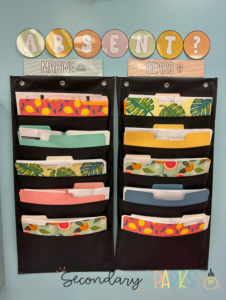
Teach the Routines
Of course, you can’t organize student absent work if students aren’t aware of the system. Ideally you want to teach this at the beginning of the year, but a mid-year change won’t hurt anyone. No matter what, stay consistent with the expectation you have set. If students know they can get away without using the system or turning in work, they will!
When setting expectations, make sure you explain where to find missing work, where to turn that missing work in, and the amount of times students have to complete the work. You might want to put this on a poster or paper and display near the absent work pick-up location.

Get Ahead…of Yourself
Teachers have an endless to-do list every day. Make organizing student absent work easy by preparing in advance. For example, you might print a few extra pages of an assignment to store in the missing work folder.
Then, when taking attendance or as students are working, jot down absent student names on the top of your extra worksheets. Then, slip those into the missing work folder. I have found putting a name on the page makes it much easier on students because there are less questions about what they need to complete.
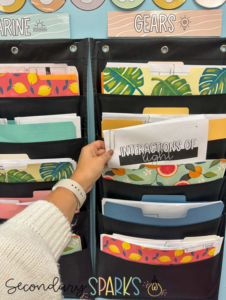
Keep it Organized
No matter which system you choose, make sure to keep it organized! You can organize your folders by unit or topic, like “light waves” or “plate tectonics”. You can also organize it by month, week, or day.
Each six weeks or quarter, go back through your files and do a clean out. You can even assign a student helper for this task!
This system to organize student absent work has saved me so much time, energy, and has saved my sanity! It also keeps my students accountable for their own work, which is a huge win.
Need another way to keep students organized? Try using agenda slides!
Leave a Reply Cancel reply
Your email address will not be published. Required fields are marked *
Save my name, email, and website in this browser for the next time I comment.

Sign up for my newsletter for freebies, teaching tips, and updates.

How to Finish All Your Missing Assignments Fast; 8 Useful Tips
When you do not submit or complete assignments on time you are faced with the challenge of missing assignments. It can be hard to keep track of all your missing assignments when they pile up but don’t worry.
First, talk with your teachers about the assignments you failed to submit and ask for a deadline extension. Then, make a plan for how to handle your work, putting the most important tasks first. Take breaks, treat yourself, and keep a good attitude to get more done. It’s not easy to make up for the schoolwork you missed, but if you’re organized and have a plan, you’ll be better able to handle whatever comes your way.
It is a daunting situation, and without the right approach, you may end up not finishing your missing assignments which will affect your overall grade. Here are critical steps that can help you finish all your missing assignments fast.
1. Create a list of all missing assignments

When working on missing assignments, you are more likely to pick the easier assignment first and forget about the tough assignments. Making a list of all your assignments helps to make sure you complete all missing assignments.
List all the missing assignments that need to be done; even if you have to re-read notes, all these tasks must be included in the list. Tick off the tasks after completion to keep you motivated.
2. Create a detailed timetable

A timetable helps you plan your tasks. Assign all your missing assignments time. Schedule more time for the tough assignments. Remember you are on a deadline, so whatever time you estimate an activity might take, reduce it by at least 5 to 10 minutes. You have to be ruthless and, at the same time, realistic when coming up with a timetable.
3. Gather all assignment materials
After listing all the missing assignments, you will have an idea of all the required materials. You must gather all the necessary tools, such as laptops and writing materials. By doing this, you ensure that you will not have to take breaks now and then to fetch something leading to time wastage. If you are the type of person who concentrates better on music in the background, this can be a great time to choose a studying playlist.

4. Switch off your devices
You must turn off all the gadgets not needed to do the assignments. These may include phones and tablets. You need to find a place with minimal distraction to enable you fully concentrate on the task at hand.
Being destructed will cost you time which could have been used to finish your missing assignments. Therefore, you can choose to keep your devices in a different room and only use them when you are on break. You can use one of the breaks already programmed to check on your social media.
5. Ask for Assignment help online
If you’re thinking “I need help with my missing assignments” and want to finish homework fast, don’t avoid getting help. There are fast writers online who will help you with your assignments – for a small price of course.
Remember that your mental health has a big effect on how much you get done. No matter how hard you try, you won’t be able to finish your assignment faster if you are tired or stressed out. Assignment help experts will relieve you of your missing assignments stress.
6. Reward yourself after finishing a missing assignment
Doing assignments may be challenging. Our brains work better when there is a possibility of getting a reward. Rewarding yourself after finishing each assignment will motivate you to continue and improve your speed.
These rewards can be a few minutes of rest, eating a snack, playing games, or spending some time on social media. These rewards should be manageable, they should not be activities that will take much of your time.
7. Avoid unnecessary breaks
Breaks are very important when doing any task, but you need to be disciplined and take breaks only when necessary to avoid wasting time. The best way to do this is by working in short sprints and taking at most a 5-minute break.
Remember, it is also not advisable to work continuously without a break. Your mind will be exhausted, and you will take longer to complete simple tasks.
To ensure you are disciplined, you need to have punishments in place if you don’t achieve your target. You can punish yourself by taking away break privileges when a task is not done as allocated.
8. Stay positive and remember what is at stake
Apart from following these steps, the most important step to finishing all your missing assignments is having a positive mindset. You must remember what is at stake, which in this case, is your academic achievement. Having this in mind will act as a form of motivational tool whenever things seem impossible.
Is it bad to have missing assignments in college?
Yes, it is bad to have incomplete assignments. You can skip some assignments without getting into trouble with the faculty, but you will lose some credits. Some lecturers are lenient and will award you partial credit for late submission of assignments, while others will give you nothing. When you miss assignments and are in an upper-division class, be sure your grades will be negatively impacted. You may not get into trouble with the faculty for missing one or two assignments, but your grades might be affected in the long run.
Do missing assignments affect your GPA?
Yes, missing assignments do affect your GPA. Missing assignments are usually given low or 0 marks which negatively impacts the grade, which is not a good thing for the student. You must maintain a GPA of 2.8 and above to have a good academic transcript. To remain competitive with the higher percentile range of students, you must have a 3.2 and above GPA score.
Can a professor drop you from a class for missing assignments?
Generally, a professor cannot drop you from a class because of missing assignments. However, this will also depend on your institution and its policy regarding missing assignments. Some lecturers are usually lenient and will pardon you for missing a few assignments, while others are stricter.
If you have any concerns about missing assignments, it is important to talk to your lecturer and understand their expectations and policies regarding missing assignments. If you are interested in getting the best results, you can contact your professor with genuine reasons why you missed the assignments and they might agree to give you partial credit that will assist in boosting your final grade.
Can I complete all my missing assignments in a day?
Yes, you can complete all missing assignments in a day. However, it will depend on the type and quantity of assignments you have. In most cases, it will be better to ask for more time instead of producing sub-standard work because of time.
Completing all missing assignments in a day will also require you to devise a good plan and implement it. You will have to stay away from any disruptions that may hinder your progress. Prior planning and communication with your lecturer will help you avoid situations whereby you have to complete a number of missing assignments within a day. You can ask for assignment help online if overwhelmed by deadlines.
Do missing assignments show up on transcripts?
No, missing assignments do not appear in your transcript; they only reduce your grades. Unlike cheating, missing assignments only affect total grades; therefore, it is better to have unsubmitted assignments than receive an “F” because of cheating. The only issue you will have on your transcript due to missing assignments is your GPA.
Can you graduate with missing assignments?
No, you cannot pass a class with missing assignments; therefore, you cannot graduate with incomplete assignments. To complete a course, some different assignments and tasks need to be completed, and failure to complete assignments will greatly affect your overall score.
Therefore, it is critical for a student to ensure that all assignments are completed and preferably on time. However, depending on the institution, you can graduate if the missing assignment didn’t greatly affect your final score.
Can a professor fail you for missing one assignment?
Not really, missing assignments will only impact your grade, and the lecturer has nothing to do with it. Most lecturers deal with several students and do not have time to deal with a particular student’s missing assignment. It is the responsibility of a student to make sure that all the assignments are completed. However, there are lecturers teaching units with few students; such lecturers have the time to follow up on individual students’ missing assignments. You need to know that even the lecturers that follow up on missing assignments will still deduct credit for a late submission.
It is completely the student’s responsibility to ensure no missing assignments. Professors do not fail students because of missing assignments because missing an assignment does not necessarily mean the student is performing badly; it might be because the student had a legitimate reason for not doing that assignment.
- Expert writers in 68 disciplines
- 8.5/10 average satisfaction rate
- Timely delivery
- Money-back guarantee
- Plagiarism-free papers
- Free revisions
- 24/7 support
How to place an order?
Take a few steps to place an order on our site:
- Fill out the form and state the deadline.
- Calculate the price of your order and pay for it with your credit card.
- When the order is placed, we select a suitable writer to complete it based on your requirements.
- Stay in contact with the writer and discuss vital details of research.
- Download a preview of the research paper. Satisfied with the outcome? Press “Approve.”
Feel secure when using our service
It's important for every customer to feel safe. Thus, at WritersABC, we take care of your security.
Get assistance with placing your order. Clarify any questions about our services. Contact our support team. They are available 24\7.
Still thinking about where to hire experienced authors and how to boost your grades? Place your order on our website and get help with any paper you need. We’ll meet your expectations.
Order now Get a quote
Managing Absent Students’ Work
- Classroom Management , Freebies , Routines & Systems
Do you struggle with managing work for absent students? For instance, when a student is absent, perhaps you aren’t sure how to make sure that student gets everything he or she needs. Maybe you feel unorganized or like you don’t have to the time to chase after the student and keep track of what was completed or not. I imagine you may even feel frustrated that you have to teach that student separately, when your time is already limited, especially if that student is frequently missing.

Managing the Work of Absent Students
When I first started teaching, I read and tried several different ideas about how to handle the work of absent students. It took me a while to find a system that I really liked and felt worked for me. I’m going to share how I handle it.
Absent buddies… with variation
At the beginning of the year, I go through the school files and take note of the attendance of the previous years for each student. I make a list of students who had excellent attendance and those who had ‘not so hot’ attendance. I keep this list in my desk until after the first few weeks of school. (I always keep in mind that there are exceptions.) Then after a few weeks into the school year, I assign my students’ absent buddies, but what I typically do is assign my students who have already demonstrated that they can’t handle responsibility well the students who are rarely absent. I do this because it saves me headache down the road and prevents any issues for the student who just doesn’t need (nor can handle) any extra responsibilities.
The Absent Report
Next, I have a very simple sheet called the absent report that sits in a folder near the front of the room. I have multiple copies of it. When there are absent students, their absent buddy is supposed to take one of these reports out of the folder and fill it out throughout the day with what we did and what is due. Then this form is left on the desk of the absent students. If by some chance (and it does happen), both students, the absent student, and the absent buddy are gone, I just fill it in. You can download this form here for free!
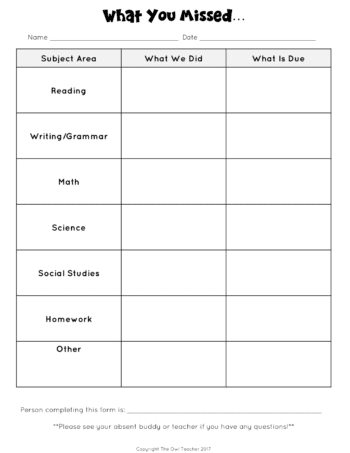
Supplying the Materials
As we work through our day and I pass out materials, I always pass them out to the absent students too. For instance, if I pass out interactive notebook pieces, I place them on the desk of an absent student. If I pass out lab sheets, you guessed it, it goes on their desk. I do not place actual manipulatives or science lab materials on their desk, but instead, leave those in a corner for students to complete upon their return as a “station.” By doing this, the student has a “collection” of materials placed on his or her desk, ready and waiting upon return. Then I don’t have to gather the materials at all!
Due Dates and Collection
In my classroom, I have a rule that after I start students on an assignment, they must try working on it on their own for at least the first five minutes. They cannot come to me and immediately say they don’t get it. During this time I move over to the desk of an absent student and verify they have all the materials needed and place a date in the corner of when it’s due. In nearly every school I have worked in, the rule has been “students get 2 days to complete work for every absence.” If a student is absent another day, I just walk by the next day and adjust. I also verify the absent buddy has written on the absent report what we did and what is due. If I have any extra notes to add, I also do it at this time.
A few notes…
At the beginning of the year, when I assign absent buddies, I also go over with students how to correctly complete the absent buddy form. It’s important that they give proper information so the absent students know how to read it upon return. I also have students place their name at the bottom after filling it out so we know who to see if we have any questions.
Upon return, the absent buddy’s job is to assist the absent student to work through what was missed. Then during my “downtime”, I can further help the student. Hopefully, by that point, my assistance is more for clarification and not much more. If the absent student is really confused and not understanding much at all, because he or she missed out on a lot of important stuff (because that is all we teach, right?), I then contact the parents and request the student to come in a little bit before school or a little after. If that doesn’t work, recess it is! (or try that first.)
If a student is absent frequently, you may need to talk to the student to see if there is a problem. Sometimes students don’t want to come to school because there is bullying happening that you may not be aware of. Other times he or she may just feel bored . No matter what, the reality is that students with frequent absences do get behind and unfortunately end up with gaps in their education. When students start to have frequent absences, the best thing you can do is talk with the administration, any school counselors, and any school social workers. It may be time for a parent-teacher conference.

- Absent Students , freebie , Managing Papers

FIND IT NOW!
Check me out on tpt.

CHECK THESE OUT

Three Types of Rocks and Minerals with Rock Cycle Circle Book

Partitioning Shapes Equal Share Fractions Halves, Thirds, Fourths Math Puzzles
Want to save time?
COPYRIGHT © 2016-2024. The Owl Teacher | Privacy page | Disclosure Page | Shipping | Returns/Refunds
BOGO on EVERYTHING!
Tips on How to Deal with Missing Assignments and Homework
- Kellie Hayden
- Categories : Classroom management tips & methodologies
- Tags : Teaching methods, tools & strategies
Tip Number 1 – Post Grades in Classroom
It sounds simple enough, but posting grades weekly allows students to see that they are indeed missing a few or many assignments. If using an electronic grade book, this is a very easy task. Some middle school and even high school students will complete the work and then forget to turn it in to the teacher.
If students are absent, some will forget to get the missing assignments. Posting grades allows students to check that they have everything turned in to the teacher.
It is best to organize the posting by student identification numbers and then list the grades from the highest grade to the lowest. This makes the grades not be in alphabetical order. This allows for anonymity when posting grades.
Tip Number 2 – Send Home Progress Reports at Midterm
At midterm, send home a progress reports to be signed by the parent. The progress report should list the grade, all the assignments and missing ones. If students do not bring back the report signed, then the teacher should call the parent.
Students immediately see their individual missing assignments. Also, this is a quick way to communicate with all of the parents. Many parents will write notes on the progress reports, call or email the teacher once the progress reports have been sent.
Tip Number 3 – Communicate with Parents
This tip probably goes without saying. However, in this busy world, it is difficult to find time to communicate with parents about missing assignments. Many parents do have email now, and it is my communication tool of choice.
Handouts, lists and progress reports can be sent via email these days. Some electronic grade books even post grades and missing assignments online. So, communicating with parents has now become somewhat easier.
Communication with the students and the parent are key to student success. If parents are unresponsive, check in the office about alternative ways of communicating with the parents. Many times students will become successful when teachers keep following up on missing assignments and show that they truly care about the student.
This post is part of the series: Classroom Mangagement Tips
These articles all center on ways to help a teacher develop classroom management skills. Tips range from behavior management to management of work and parents.
- Top Five Classroom Management Strategies – They Really Work
- How to Deal with Missing Assignments
- How to Deal with Angry Parents
Teach Starter, part of Tes Teach Starter, part of Tes
Search everything in all resources
Missing Assignment Templates
Updated: 13 Jun 2024
Promote student accountability for completing assignments with a printable missing work log and parent contact form.
Editable: Google Slides
Non-Editable: PDF
Pages: 1 Page
Grades: 3 - 7
Differentiated: Yes
- Printable PDF (pdf) Sign up to Plus
- Google Slides Sign up to Plus
Get inspired!
Tag #TeachStarter on Instagram for a chance to be featured!
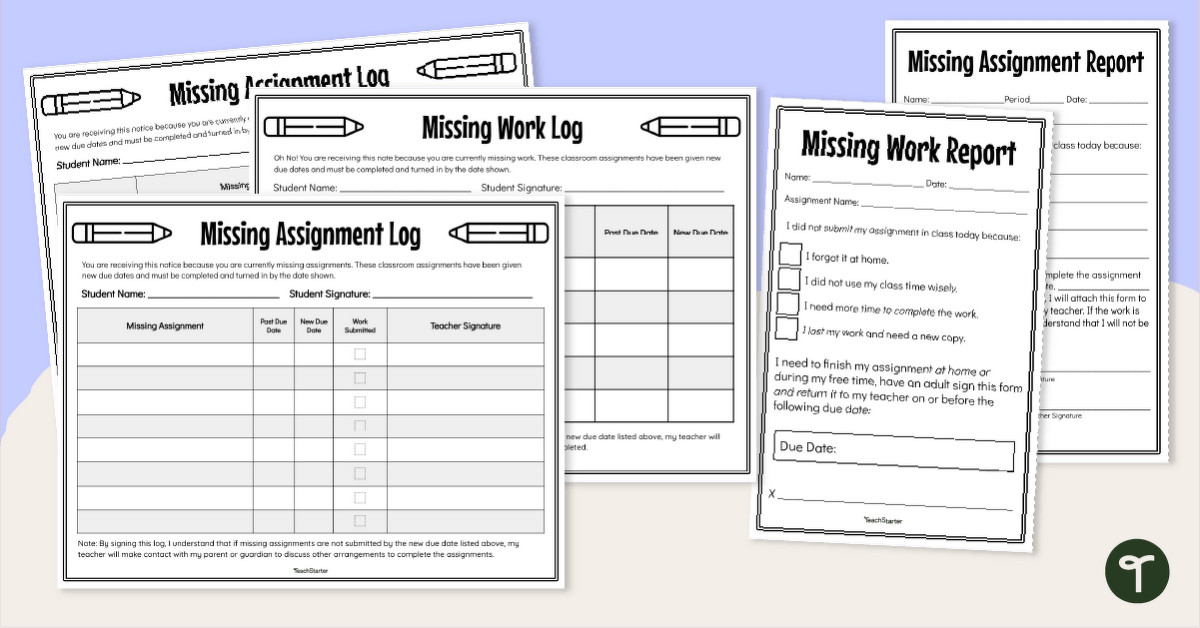
What Do You Do About Missing Assignments?
Missing assignments…one of the biggest challenges for the classroom teacher. It’s really tough when you get to the end of a grading period and suddenly you realize students have missing assignments that are really affecting their end-of-term grades. You definitely want their grades to reflect their abilities, and you definitely don’t want parents suddenly wondering why there are low grades on their report cards…so we’ve put together an easy solution for you!
Hold Students Accountable with Missing Assignment Templates
This year, we invite you to promote student accountability in your classroom with our printable Missing Assignment Logs and parent communication notes. We’ve created a handy set of differentiated templates for you to use to notify students and parents of missing assignments, plus an easy way for you to keep track of which students owe work and which ones have submitted late work already. This resource download includes:
- Missing Assignment Log for Younger Students
- Missing Assignment Log for Older Students
- Missing Assignment Log with Teacher Signature Option
- Missing Assignment Note for Younger Students – This form requires students to fill out what assignment they did not complete and why it wasn’t completed. It also provides a place for parents to sign when they finish.
- Missing Assignment Note for Older Students – This form requires students to fill out what was not completed, write to explain why they didn’t submit the work, and sign stating that they understand the consequences of their actions.
Download and Celebrate No Missing Assignments!
This resource is available as an easy-to-use Google Slides or Printable PDF Resource file. To get your copy, click the dropdown arrow on the download button to select the file format you prefer.
This resource was created by Lisamarie Del Valle, a teacher in Florida and Teach Starter Collaborator.
Even More Ways to Become an Organized Teacher!
Looking for more ways to help you organize your school year? Make sure you check out these handy resources before you go!
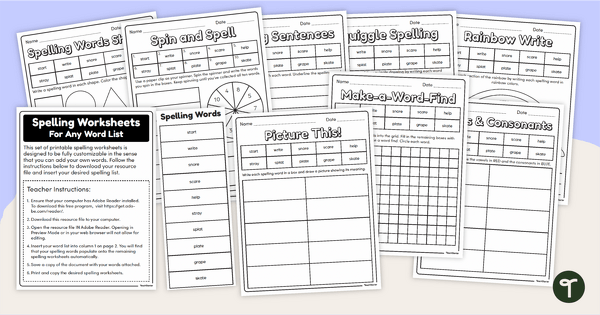
teaching resource
Auto-fill customizable spelling worksheets.
Save time making custom spelling lists and spelling practice worksheets with an editable auto-fill spelling worksheet pack.
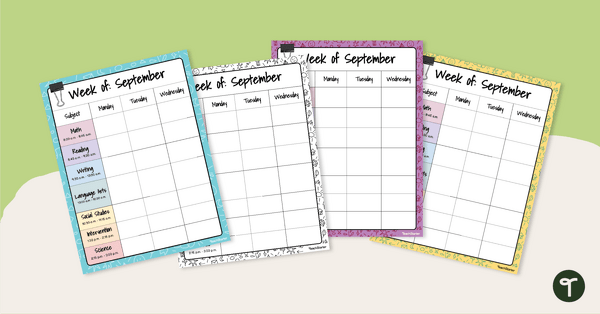
Editable Weekly Lesson Plan Template
Stay organized for the week with this editable lesson plan template.
Tiered Tracker for Student Intervention Template
Track student progress and response to intervention with a handy Student Intervention Tracking Data Sheet.
Teach Starter Publishing
We create premium quality, downloadable teaching resources for primary/elementary school teachers that make classrooms buzz!
Write a review to help other teachers and parents like yourself. If you'd like to request a change to this resource, or report an error, select the corresponding tab above.
Suggest a Change
Would you like something changed or customised on this resource? While our team makes every effort to complete change suggestions, we can't guarantee that every change will be completed.
Report an Error
Did you spot an error on this resource? Please let us know and we will fix it shortly.
Are you having trouble downloading or viewing this resource? Please try the following steps:
- Check that you are logged in to your account
- For premium resources, check that you have a paid subscription
- Check that you have installed Adobe Reader ( download here )
If you are still having difficulty, please visit the Teach Starter Help Desk or contact us .
You may also like
- Classroom Procedures →
- Back to School 2024 →
- Templates →
- Graphic Organizers →
- Classroom Communication →
- Parent Teacher Communication →
- Classroom Routines →
- Forms and Checklists →
- Student Data Tracking Forms →
- Classroom Tools →
- 3rd Grade →
- 4th Grade →
- 5th Grade →
- 6th Grade →
- 7th Grade →
- Google Slide →

Student Gift Tags – Your Future's So Bright I Have to Wear Shades
Brighten your students' end of year when you give them special end of year student gifts wearing these 'Future So Bright' student gift tags!
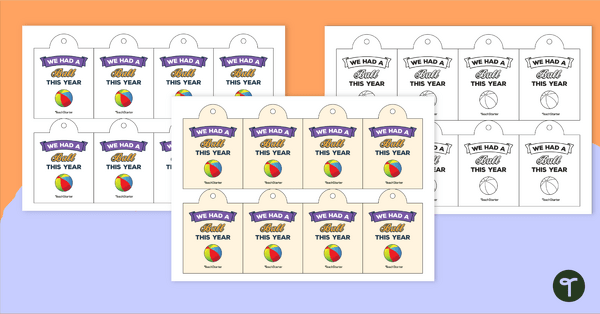
End-of-Year Student Gift Tags – We Had a Ball This Year
Have a ball making end of year gifts for students with our printable student gift tags.

Student Gift Tags – Owl Miss You
Let your students know how much you will miss them with this end-of-year gift tag.
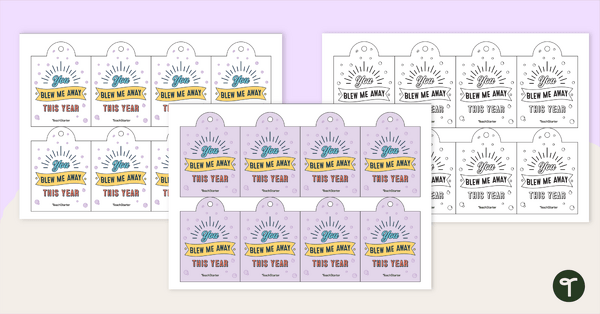
Student Gift Tags – You Blew Me Away This Year
Blow your students away with fun end of year gifts wearing these adorable end-of-year gift tags!
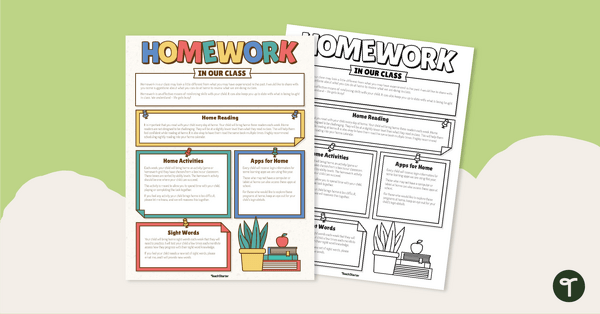
Homework Information Sheet - Editable Template
Inform parents of what homework will look like in your classroom with this editable template.
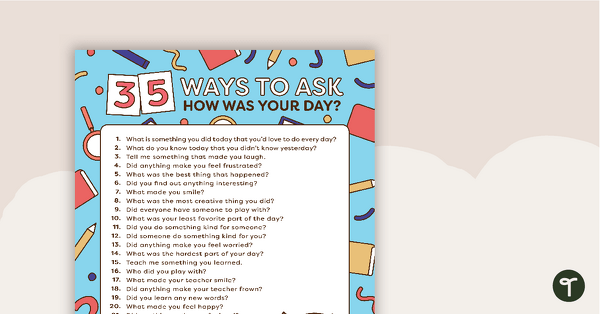
35 Ways to Ask "How Was Your Day?" Poster
Help your parents communicate with their children using these 35 questions.
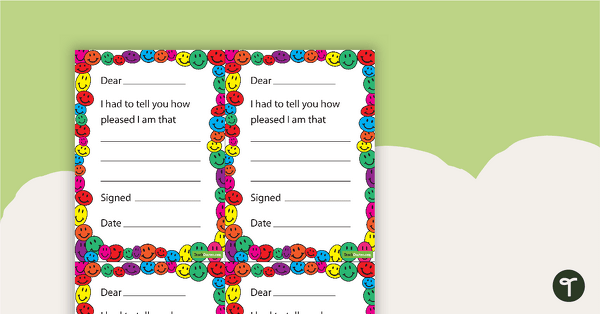
Positive Parent Notes - Smiley Faces
Let your students parents know when they have done particularly well or shown good behavior with a Positive Parent Note.
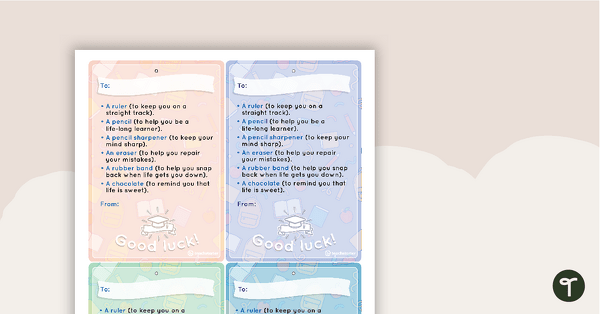
Student Gift Tag - Top of the Class
A cute gift tag to attach to an end-of-year gift for your students.
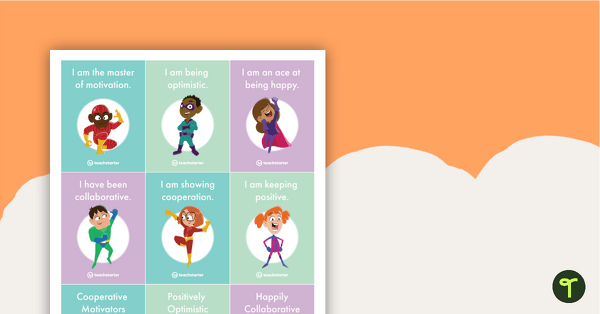
Emotion Demotion - Brag Tags
Use these brag tags to encourage and celebrate positive social behavior in the classroom.

Back to School – Parent Information Slide Templates
Plan out your parent information night or meet the teacher event with this set of 19 slides.
- Mission and vision
- Faculty and staff
- Bayesian Analysis of Academic Outcomes from Single Case Experimental Designs
- Catch and Release
- Links to Learning: Adaptive Math Assessment (LLAMA)
- Parents Plus
- Project PEAK
- Lehigh Reach Lab
- Project RISE
- Meet the Team
- Year 1 Activities (2021-2022)
- Year 2 Activities (2022-2023)
- Year 3 Activities (2023-2024)
- Year 4 Activities (2024-2025)
- Project STAY Presentations
- Frequently Asked Questions
- Contact Information
- Sponsored Research Agreement with Renaissance Learning
- Supported College and Career Readiness
- Classroom-wide interventions
Missing assignment tracking
- Organization checklist
- Resources for Parents
- Resources for Mental Health Providers
- Lehigh University Autism Services
What is the intervention? Assignment tracking is an easy to use system that assists students to keep track of their assignments. Students track assignments, due dates and when they are completed.
Who is it for? Students of all ages.
Purpose: This system teaches student’s time and material management skills. This system allows students to track their assignments and also gives them the opportunity to turn in the work in time enough to earn credit.
Materials: Missing Assignment Tracking Reference Guide Missing Assignment Tracking Student Form
- Identify the students who have less than 90% of their work turned in and what assignments they are missing.
- Create a brief introduction to present this system and work with the student to implement the intervention using the steps described in the Missing Assignment Tracking Reference Sheet.
Missing Assignment Tracking Reference Guide Missing Assignment Tracking Student Form
Top 7 Homework Planner Apps for Students
Whether you are attending classes, completing your assignments, studying for a quiz, project work, extra-curricular activities, or squeezing some time for friends and family. You’d agree that organizing and planning goes a long way. That’s why a homework organizer or a homework planner app can be a lifesaver to keep track of all your assignments, tests, submission deadlines, and exams. I did the research and shortlisted the perfect homework planner apps for Android and iOS. Let’s check those out.
Read: Best Notes App for Windows to Increase Productivity
Homework Planner Apps for Students
1. student planner- homework agenda & notes.
The first app on the list is a simple homework and notes management app. It keeps track of homework, assignments, projects, and to-do lists. The layout is minimal, all the tasks are neatly organized with a colored bookmark for easy identification. You can mark a task complete and remove it from the pending list.
Courses can be added easily and color-coded as well. The calendar shows any upcoming deadlines so you can prioritize accordingly. The tasks have a progress bar that you can adjust as you make progress which enables you to get a quick summary without actually opening every task.
You can also break your assignments in small chunks as subtasks that would make finishing a task much easier and the progress bar will fill automatically. It also allows you to attach media files to your assignments or projects for easy access to the important information in one place.

- Progress bar
- Deadline Reminders
- Calendar View
- No option to sync data to the cloud
Student Planner is a great app for all the students, it has all the necessary features like Deadline reminders, subtasks, progress bar, color-coded tasks, and courses. It can significantly increase your productivity when used regularly. You can get this app for free in the Play Store.
Install Student Planner- Homework Agenda ( Android )
2. Student Planner
Student Planner is another fast and simple homework management app which is wrapped by a beautiful and intuitive material designed UI. What Student Planner adds to the table is the inclusion of a schedule or time table which you can use to either store your class schedule or it might even be a study schedule for your exams.
You first start by adding your subject and the schedule then you can add an assignment or set a reminder. The due assignments are arranged as separate cards and can be swiped away once done with.

- Simple and easy to get started with
- Fast and small in size
- Beautiful Minimal UI
- Option for Schedule
- No sync/backup
- Timetable implementation not perfect
I would recommend this app to anyone who is looking for a simple homework management app with timetable support and a minimal UI.
Install Student Planner ( Android )
Egenda is simple. Open the app, add all the classes or subjects to the app, and once that is set up, you have the option of adding a new Homework, Quiz, Project, or Test and choose the respective subject deadlines. The app also arranges the due work in cards that can be swiped away when done. But what I love the most about this app is that the fact it allows you to go subject-wise and view all your upcoming tests, projects, or pending assignments which is a huge convenience for planning your schedule ahead of time instead of the previous day.
Unfortunately, the app doesn’t have a timetable option, but in its latest update, it added a Calendar View where you can see your whole month at a glance with your assignments, tests, and projects.
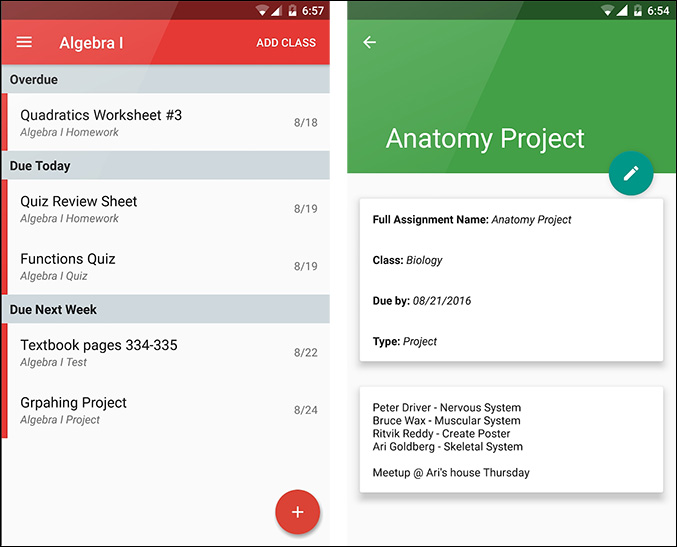
- Subject-wise sorting
- Calendar View
- No timetable support
Egenda provides some great tools for Homework and Test planning and I am sure anyone would find them extremely convenient and useful. But keeping its single con in mind, go for this app if you are not too keen on having a schedule or timetable.
Install Egenda ( Android | iOS )
4. ChalkBoard
The next app on our list is ChalkBoard, which I found out to be a pretty smart homework planner app. Chalkboard strikes a perfect balance between simplicity and features.
Although the setup process is a little longer than the previous three apps, as you have to feed meticulous details about the classes, teacher, and schedule. It is worth the effort.
On the home screen, you are shown upcoming classes, events tab, and upcoming tests. ChalkBoard fetches the dates for every subject from the Timetable for your future classes. Little features like these make the app stand out from the rest and give an overall great experience. You can also view classes and assignments subject wise.
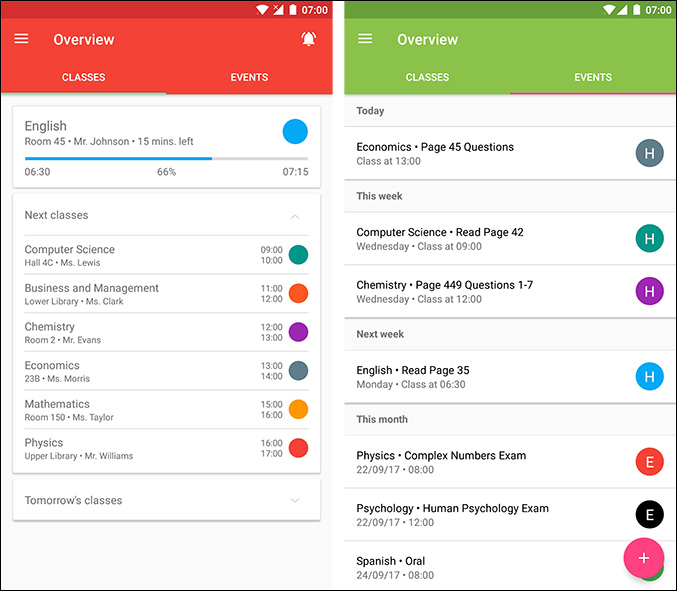
- Proper Timetable
- Ability to add teachers for subjects
- View tomorrow’s classes as well as assignments/tests/quizzes
- Smart features
- Little longer to set up
- No calendar view
If you are looking for a homework planner as well as a school planner, Chalkboard is the app as it strikes a great ground with almost all the features one might need while not being too bulky.
Install ChalkBoard ( Android )
5. School Planner
School Planner is a full-fledged planning application designed for students to manage their career as a student. Along with your homework and timetables, School Planner offers you to keep track of your grades and attendance, add contacts for teachers, add recorded lectures, and even multiple planners.
The app supports backing up of all your data via Google Drive, Calendar View along with a weekly report, attaching snapshots to your assignment reminders, student accounts from ClassViva, and a lot more. In spite of so many features, the app doesn’t feel slow at all and delivers a powerful performance with its beautiful design.

- Full-fledged student companion
- Feature-packed and free
- Supports sync and backup
- Widget Support
- Tedious setup procedure
- Big in size
- Complex, not so smooth learning curve
While it is not for someone who is looking for a fast and easy way into homework management, School Planner is a great student companion app and serious students will surely get the most out of hit.
Install School Planner ( Android )
6. My Study Life
My Study Life comes with its own web app and syncs with the Android app, essentially making your data accessible from any device as long as it has a browser.
It implements a goal-centric circular tracker that shows your progress. The Calendar view combines your timetable, deadlines, and shows all your classes and assignments, projects in a single place.
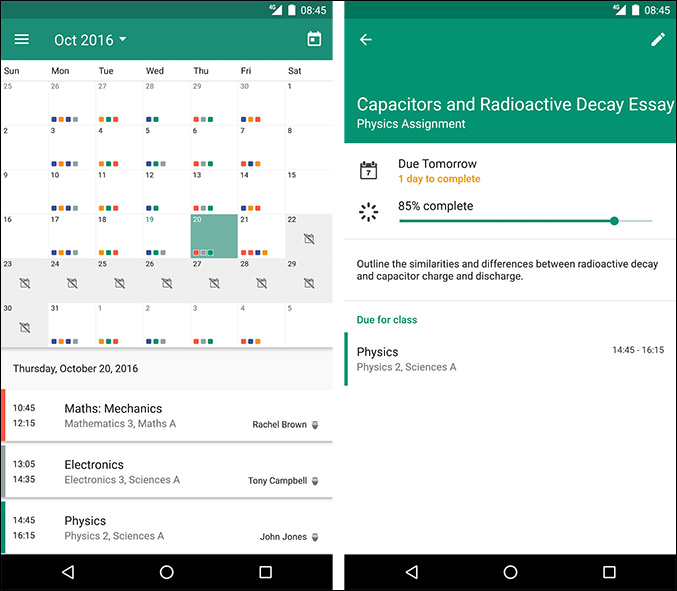
- Refreshingly new UI
- Access from anywhere through its web app
- Sync and Backup
- Lengthy setup process
If you study from your computer or laptop, My Study Life makes it easy to access your homework planner on your phone from your computer, while not compromising on features and being completely free. What more can you ask for?
Install My Study Life ( Android | iOS )
7. iStudiez Pro
Like School Planner, iStudiez Pro includes grading and subject wise organization of tasks. iStudiez Pro takes it further with the integration of Google Calendar that allows you to directly get all your holidays, exam schedule, routine from Google Calendar itself.
It also offers separate apps on all platforms including iOS, Mac, and Windows. All the apps sync seamlessly between themselves, so studying on your computer consulting your planner won’t be an issue.
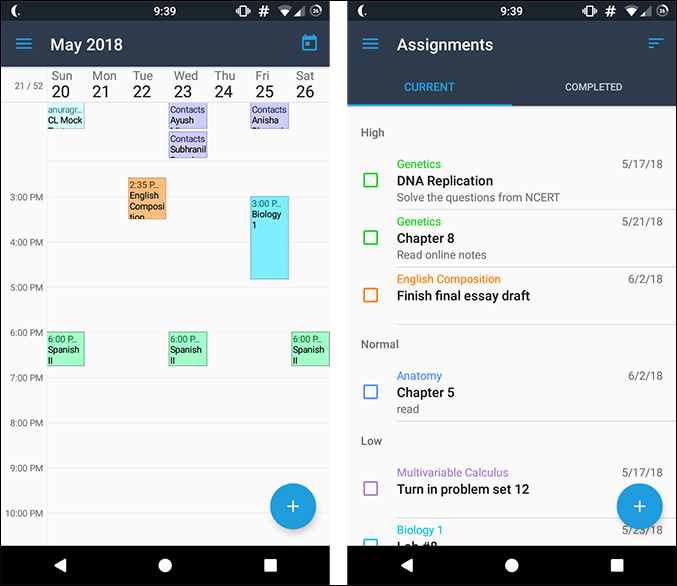
- Google Calendar Integration
- Cross-Platform
- Cumulative Price
If Google Calendar integration and cross-platform support is a must for you, iStudiez Pro is definitely the app you want.
Install iStudiez Pro ( Android | iOS )
So this was our roundup of the best homework planner apps for Android. We genuinely think that there is an app for every need and we hope that you found a Homework Planner that suits your need whether you are a high school student or a college senior. So which one was your favorite or did we forget to add yours? Let us know in the comments below.
Also Read: Take a Picture of Handwriting And Convert to Text – Android Apps
Sometimes I write. Business Enquiries: [email protected]
You may also like
Can someone see what i search on google..., these apple watch models will get the watchos..., will your ipad model get ipados 18 update..., how to create polls on discord channel, 6 fixes for samsung tv or monitor stuck..., a guide to using phone link on windows..., what is secret mode in samsung internet and..., you can share location using this siri shortcut..., this siri shortcut for iphone can help when..., what does the bell icon mean on various..., leave a comment cancel reply.
You must be logged in to post a comment.
Steals & Deals: Up to 86% off pickleball accessories, sunglasses, 3-in-1 beach chair, more
- Share this —

- Watch Full Episodes
- Read With Jenna
- Inspirational
- Relationships
- TODAY Table
- Newsletters
- Start TODAY
- Shop TODAY Awards
- Citi Concert Series
- Listen All Day
Follow today
More Brands
- On The Show
- TODAY Plaza
5 apps to keep track of homework assignments
The new school year is almost upon us, and there's no time like today to get ready.
Whether you are the student or it's someone else in your family, it's important to keep things organized and on track from day one.
While these apps can be useful for a wide age group, be sure and check with your local school district to ensure you're not breaking any rules by sending your child or teen to school with a smartphone.
1. Evernote Price: Free Download: Evernote for iPhone / iPod Touch / iPad , Android , Window Phone 7 , BlackBerry , Palm Pre / Palm Pixi , Mac , Windows , web .
While it's not an actual planner or calendar app, if you take notes to stay organized, then Evernote is for you. Take photos, copy web pages, save PDF files or just take notes and organize them all into folders. Search for your notes via tags or keywords in the notes themselves. Evernote can even search for words located in pictures you've taken — a pretty cool feature.
You'll never lose another sticky note or forget a reading assignment when you jot it down in Evernote. Just pull up your notes on whatever device you have, wherever you are. Free accounts are allowed up to 60MB of upload (or synchronized) data per month, which can be upgraded for $5 per month or $45 per year.
2. FC Tasks Price : $5.99 Download : FC Tasks for iPhone .
FranklinCovey is one of the best-known names when it comes to pencil and paper (even digital stand-alone) day planners. You would expect this company to have a mobile app to help make our lives more organized, and you would be right.
The FC Tasks app is a great stand-alone mobile product for anyone who's used to using the FranklinCovey system of productivity and time management. You'll see the familiar ABC-123 ranking method for all the task lists, but that's only the beginning. With this app, you can create recurring tasks, create multimedia tasks, delegate tasks via email and more. This is a top-of-the-line app from a top-of-the-line company.
3. Remember the Milk Price: Free to download; requires Remember the Milk Pro for Android and BlackBerry users. Download: Remember the Milk for iPhone / iPad , Android , BlackBerry .
Remember the Milk is a great to-do list service. The basic service is available online and can be integrated with web apps such as Gmail, desktop apps such as Outlook and the mobile app platforms listed above. Set your tasks, prioritize and get email alerts when they are due. It's everything you want in a to-do list.
While the web app is great, taking Remember the Milk on the road is the key to making this app work for you. Browser add-ons and widgets for other apps such as Gmail make this service seamless with other apps that you're already using. Read more in our Remember the Milk review .
4. ToDoMatrix Price : Free Download : ToDoMatrix for iPhone , BlackBerry .
The free version of the ToDoMatrix app is limited to six folders and 30 tasks, which is probably enough for you if you're a casual user. If you're looking for something more than just a homework tracking app, you'll want to look at in-app upgrades to remove these limits.
What started as a productivity app designed for business-minded BlackBerry users has made the transition to mainstream with the debut of its iOS app. Organize tasks, set flexible reminders, delegate and view just what you want with multiple display options. Your data is encrypted and backed up wirelessly to the cloud. If you're a BlackBerry user, you probably already know about this one; if not, it's definitely worth checking out the free version to see if it meets your needs.
5. Google Calendar Price : Free Download : Google Calendar for web , iPhone Sync , Windows Mobile Sync , BlackBerry Sync .
We've saved the best for last, despite the non-app status of this service. We think you'll agree once you see how seamlessly this free service from Google integrates with literally all of your devices. Start out on the web app and set up your calendars. From there, you can sync your calendar to all of the major mobile operating systems out there.
Google Calendar doesn't miss a beat with Google's own Android OS , as would be expected. Once you set up your Android device, it's an automatic sync with the Google apps on your mobile device. If you're on another operating system, syncing the built-in calendars on these mobile devices to your Google Calendar account is simple. There are few limitations, flexible reminders, multiple calendars, share features and more.
Getting your time back It takes a little practice to see which planner or homework tracking app is going to work best for you. Don't wait until the last minute. Start now, before school kicks off, and try them all (or at least the free ones). Once you've settled on which app design works for you, don't look back. There's no point in second guessing your choice, and once school starts, you will want to feel confident in your ability to use your app to organize your time so you don't miss any important deadlines.
More from Tecca:
- The best apps for taking notes in class
- Springpad organizes your life
- How to get big discounts from daily deal sites

What Alicia Keys has shared about her kids with Swizz Beatz

Kate Middleton captures Prince William and kids at beach in touching Father’s Day photo

How Kevin Costner's 15-year-old son ended up in the movie star's latest film

Angelina Jolie attends Tony Awards with daughter Vivienne

Hoda Kotb shares photo of ex Joel Schiffman with daughters for Father’s Day: ‘Best dad’

Brittany Mahomes, Victoria Beckham and more share Father’s Day tributes

Henry Cavill gives sneak peek of baby’s nursery ahead of birth of his first child

Al Roker gives hilarious advice to dads on Father’s Day: ‘Nobody can tell you what to do’

Kim Kardashian’s kids: What she’s shared about North, Saint, Chicago and Psalm

Remains of missing 8-month-old girl found hidden in Kentucky home
Teacher Off Duty
Resources to help you teach better and live happier

Missing Assignment Check Organizer
An organizer for students to use to keep track of their missing and low assignments–PERFECT for use in a study hall, AVID class, or even counseling! This handout ALSO includes a free, engaging and motivating lesson plan to help you use it in your classroom.
Description
- Reviews (0)
Before I created the missing and low assignment check, I would have students making a list of missing assignments on a blank piece of paper, haphazardly explaining what each grade marking meant. Especially for students that struggled to keep organized, this did not prove to be very effective, and I knew they wouldn’t be able to handle it with me absent. My students needed something structured and consistent so they could do it independently. Advocacy and organization is a learned skill, and this was a simple but structured enough handout to help teach that. As I made copies, I had more and more teachers asking me for it, so I decided to offer it on my store!
While I’ve primarily used this with 6th graders, it can be used with secondary students of all ages.
**Note**: this is part of a bundle! You can buy the entire bundle for a discounted price, including this product here: Student Success Log BUNDLE
If you prefer to purchase items from the bundle ala carte, you can find them below: Tracking my GPA Graph Calculating my GPA Organizer Student Success Log
I would love to help you and your students with this organizer. If you purchase this product, I only ask that you please respect the Terms of Use by leaving an honest review of this product so that I might help more teachers and students like you and yours!
You can also purchase this product through my Teachers Pay Teachers store here.
There are no reviews yet.
Your email address will not be published. Required fields are marked *
Your review *
Name *
Email *
Notify me of new posts by email.
Related products

Calculating my GPA Organizer

GPA Goal Bundle

Study Habit Log

Tracking my GPA Graph
Looking for something.
- Resource Shop
- Partnerships
Information
We are a participant in the Amazon Services LLC Associates Program, an affiliate advertising program designed to provide a means for us to earn fees by linking to Amazon.com and affiliated sites.
New Teacher Corner
New teachers are my favorite teachers..
- Forms for Educators
- Apply for a discount
- Sign Up for Free
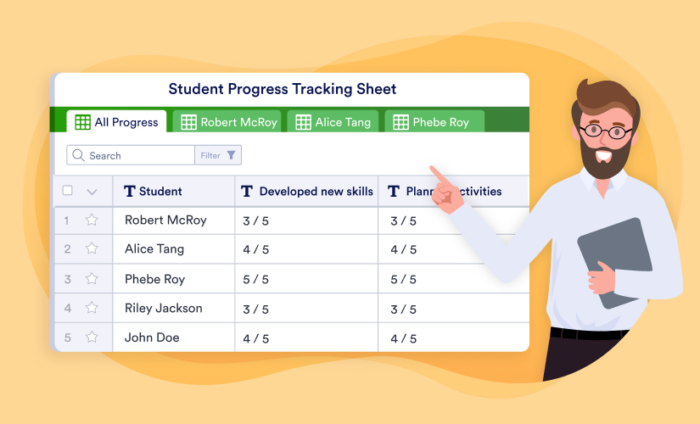
- Educational Technology
How to track student progress
Effective teachers don’t just deliver quality educational opportunities — they also diligently track student progress to measure results. Tracking progress benefits both students and teachers. Students can see how they’re doing in various subjects, and teachers can see which of their teaching approaches are working and where they might need to make adjustments.
Of course, tracking is necessary to ensure you meet state standards, but checking off whether you’ve covered curriculum requirements doesn’t necessarily mean that your students are learning the required skills. Tracking student growth lets you know how and when to adjust information as you teach to make sure students are actually learning.
When your students are performing well, for example, you can move forward in the lessons to keep the group engaged. If you see that students aren’t mastering the skills, then you can slow the schedule to review the necessary lessons. Keeping track of performance data gives you the ability to respond quickly and optimize your students’ education.
Student progress tracking also indicates when it’s time to celebrate a student’s successes. It’s important not to miss opportunities to recognize when and how a student has improved.
Conduct student progress reports seamlessly on any device with Jotform .
Best practices for student progress tracking
For the best results, design your tracking system according to your classroom’s needs and your organizational style. Find the balance between collecting the most relevant information and making the system simple enough that you can stay consistent with regular updates.
In addition to collecting data for your own purposes, look for ways to communicate the results to your students. When students can see the information you’re tracking, it can help motivate them to improve their performance. Encourage them to track their personal progress.
Once you’ve created a student tracking system and you’re proactively recording student data, you’ll start to see trends over time. Consider adding a reminder on your calendar so that you have a dedicated time each week to update the data and evaluate your students’ performance.
For an insightful look into the future of higher education, explore “ 8 Top Trends in Higher Education to Watch in 2024 ” on Jotform’s blog.
What should you track in the classroom?
Don’t just adopt a generic tracking system. Customize your system according to the students’ grade level, the goals for the school year, and the content you’re teaching.
Here are some examples of data you might collect when tracking student progress:
- Test and quiz scores
- Homework completion rates
- Assignment scores
- Number of reading hours
- Behavior assessments
- Assessments of students’ knowledge and abilities before instruction
The key to success is making sure your student tracking forms are always up to date.
What to look for in a tracking system
When deciding how you’ll track student progress, make sure the system you select is simple and easy to maintain. You’ve already got enough on your to-do list with planning lessons, grading, meeting with parents, and taking care of the many other tasks that fill your school days.
Additionally, you need a student tracking system that consolidates data into an easy-to-understand format. Look for a system that allows you to enter data on forms or spreadsheets and then analyze and review that information in reports.
Clipboards and paper binders can be burdensome because they require a lot of manual work to collect and analyze data. Instead, look for a digital system that combines everything into tables and summaries.
Not only will these reporting formats make it easy for you to understand the information, but you’ll also have shareable PDF documents to use during conversations with parents and other educators.
How Jotform can help with student tracking
Jotform is an effective solution for tracking student progress. The forms allow you to customize your tracking system and optimize the information you gather to get the most useful insights about each student.
Jotform offers a variety of templates for forms, tables, and PDFs. Each template is customizable to match your unique needs. Consider using the student progress tracking sheet , student progress report form , and student progress evaluation form for your classroom. You can share the information you gather through Jotform, or you can export the data through third-party integrations.
These online school forms for teachers are user-friendly, and Jotform offers teachers a 50 percent educator discount. Data-collection and analysis features make it simple for teachers and educators to gather information with ease.
Thank you for helping improve the Jotform Blog. 🎉
RECOMMENDED ARTICLES

What is Educational Technology?

How to manage evaluations in education

The 5 best online teaching platforms in 2024

9 of the best apps for parent-teacher communication

How to Make a Standout Online Scholarship Application Form

What is a virtual classroom?

3 important questions about education data collection

5 benefits of online learning

3 of the top online learning platforms

The benefits of admissions and enrollment management software

Sending Your Graduation Party Invitations with Jotform
The importance of student attendance tracking software
The pros and cons of academic tracking

Homework in digital classrooms

How to engage your alumni to support your school

How EdTech supports inclusive classrooms

What is microlearning?

10 Schoology alternatives in 2024

35 top course evaluation question examples

How to embed a form on a Thinkific page

9 online form integrations to try this school year

How to hold virtual parent-teacher meetings on Zoom

Automated schools: 7 school processes you can automate

How private schools can recruit top students

How to minimize the disruption of school campus tours

How to host a virtual open house for your school

Quizlet vs Kahoot!: A comparative guide for educators

8 tips for using Zoom for online learning

Educational Uses of Jotform

10 best school management software tools

How to organize a read-a-thon fundraiser

How to conduct remote student assessments

5 tips for creating a virtual learning environment

20 questions to ask alumni

Google Classroom vs Canvas: Features, pricing, and more

Quizizz vs Kahoot!: Choosing the right quiz platform

5 Jotform Widgets to Utilize This School Year

Top 15 learning management system examples

Top 8 fundraising platforms for schools

School web design: 3 tips to engage students and parents

Webinar: 6 ways Jotform Enterprise can help your school do it all

An overview of Google Classroom’s pricing plans for K–12

10 tips for healthy parent-teacher communication

How to encourage digital creativity this school year

Blooket vs Kahoot!: Comparing interactive learning platforms

Safe and private: How to use forms to facilitate social justice conversations with students

Top scholarship management software

How to optimize an IEP meeting: 5 best practices

Gamifying your curriculum with Blooket vs Gimkit

11 ways to use Jotform for distance learning

How teachers do it: Saving time with tech tools

Formative and summative assessments: How the right technology enhances learning

Announcing our 2022 back-to-school toolkit

EdTech in 2025: A glimpse into education’s future

How to create online courses

How online tools provide more individualized lessons

Free online tools for teachers, recommended by teachers

How to plan a school field trip

How to create a remote learning plan

What is EdTech and what are its benefits?

Top 7 Quizlet alternatives in 2024

Create digital reading logs for students with Jotform

How to become a paperless school

15 podcasts for teachers to further professional development

Remind vs GroupMe: Which student communication tool to use

Learning analytics in education

Need new skills? These online learning platforms can help

Top free software for students

5 EdTech companies helping students and educators

How to design accessible online courses

26 questions to ask at a parent-teacher conference

Tracking success: 4 easy ways to assess student learning

Using tech to keep students with food allergies safe

Online Forms: A Teacher’s Best Friend

7 higher education apps to be more efficient in 2020

Canvas vs Moodle: Comparing digital classrooms

How digital tools can help teachers collaborate on lesson plans

How to Use Jotform for Education (Movie)

How to monitor student progress in special education

How to share your student data with colleagues

LearnWorlds pricing plans: Which one is right for you?

How to offer virtual office hours to your students

How a Teacher Uses Jotform to Help Her Students

How school counselors use data to help students succeed

Professional development for teachers: Importance of feedback for teachers

Quizizz vs Quizlet: A close-up look at 2 top quiz tools

Top 5 Kahoot! alternatives in 2024

4 educational technology tools transforming the classroom

What’s the best classroom response system?

Top 5 classroom polling tools to engage students

The anatomy of a data-rich teacher evaluation form

11 best class registration software solutions for 2024

Top 8 online quiz makers for teachers

How to review a scholarship application

LearnWorlds vs Thinkific: Which is best for online courses?

Methods to utilize technology for school administrators

How to create personalized learning plans for students with undiagnosed disabilities

What is distance learning?

Benefits and challenges of mobile learning

Moodle LMS pricing: Which plan fits your learning journey?
Send Comment :
1 Comments:
More than a year ago
An interesting article, it's a pity not all teachers are interested in tracking the progress of students.
- Project Management
How to Keep Track of Tasks at Work? 8 Methods for Task Management
2019 - Present Marketing specialist Innovative content marketeer with MSc in International Communication, Mindaugas brings fresh ideas and inspiration about project management and beyond.

Some project managers seem to have it all together, while others are constantly in crisis mode. Evidence from top productive people shows that the secret often lies in how they organize and track their tasks.
CEOs like Elon Musk use time blocking to schedule specific tasks during specific times of the day. Investor Warren Buffett has its own 5/25 Warren Buffett rule. With countless other examples, it’s clear there are proven strategies that help to keep the tasks in control. But what can you take from these strategies home?
Today, I’ll explore the top methods that help to keep track of tasks. We’ll look at practical tips and real-world examples that have the potential to transform how you manage your workload , with one clear aim—to help you maintain your sanity and boost productivity.
Why is it beneficial to keep track of tasks?

Keeping track of tasks is beneficial for multiple reasons:
- Improved productivity – Tracking tasks helps you prioritize better, stay focused, and manage your time efficiently.
- Organization – With a central place to store all project information, task tracking keeps everything and everyone organized.
- Better collaboration – Sharing task lists, assigning tasks, and communicating effectively through task tracking software reduces misunderstandings.
- Accountability – Task tracking makes it clear who is responsible for what and when to prevent scope creep .
- Data-driven decisions – Insights from task tracking reveal work patterns and time allocation.
- Early problem detection – Noticing potential issues early, such as delays or obstacles, task tracking allows you to address problems early.
- Accurate time and budget estimates – Task tracking provides data on how long tasks take, helping you make accurate time estimates and keep future projects within budget.
- Motivation – Breaking down big tasks into smaller steps and tracking progress keeps you motivated and gives a clear view of your achievements.
Strategies for keeping track of tasks
These strategies provide a roadmap for prioritizing tasks, managing time effectively, and boosting productivity.
1. Set clear goals
It might seem obvious, but teams often lose sight of the bigger picture while standardizing processes, including task creation and tracking.
When you first define your objectives with precision, you create a roadmap that guides you through every step of the process. When you’re building workflows, sticking to the SMART criteria (Specific, Measurable, Achievable, Relevant, Time-bound) might be the best practice to start with.
For example, instead of “Improve project documentation,” you can specify “Create a comprehensive project documentation template by the end of this month.”
The NCT is another approach to tracking weekly goals that involves crafting a narrative, establishing 3 to 5 commitments, and identifying tasks aligned with these commitments. This clarity brings bigger purpose and direction to your team’s efforts and makes task tracking more strategic.
2. Break down large tasks into smaller ones
That sinking feeling when staring down a massive project—sounds familiar? But there is always a simple fix: break those mammoth tasks into bite-sized chunks. Focus on tackling each small task, and suddenly, the workload seems lighter. Plus, it’s a time-saver—organizing your day becomes simpler.
When you break tasks down, you’re not just making life easier for yourself – you’re also making it easier for your team. And don’t forget to keep everyone in the loop with detailed documentation. When your team sees a clear plan, teamwork improves.

3. Prioritize tasks
The art of prioritization , putting less crucial tasks on hold to concentrate on what truly matters, is a skill in itself.
Parkinson’s Law highlights how work tends to expand to fit the time allocated for its completion. To avoid that, start prioritizing by evaluating tasks based on their importance and urgency.
Focus on completing tasks with a high impact on your goals while delegating or scheduling less critical ones accordingly. Also, stay flexible and adapt your priorities as needed. This will help you focus clearly on one task at a time to maximize productivity.
Remember, it’s okay to say “no” and remove distractions to protect your time and energy. Prioritizing self-care and regular reassessments ensure you’re always on track with your tasks.
4. Use a calendar
Using a calendar effectively can revolutionize how you manage tasks and organize your daily life.
Scheduling focused time blocks ensures that important tasks are at least completed. Integrate task management apps with your calendar for task tracking and use color-coding or separate calendars to maintain clarity.
As an alternative, you might want to use a digital Teamhood calendar with a timeline view , which is suited for scheduling tasks on the calendar. Unlike the Gantt view, this perspective allows you to view all workspace boards in a single location and effortlessly establish task dependencies across them.
Avoid cluttering your calendar with non-essential tasks and prioritize self-care by blocking time for relaxation and recharge. These strategies will help you optimize your productivity and stay on top of your tasks easily.
Visual project management for high performing teams
Start managing your team effectively
Get Started For Free

5. Create task dependencies
Task dependencies offer a structured approach to defining relationships between tasks and visualizing their sequence.
The first approach involves examining how tasks rely on each other, whether it’s based on resources, personnel, projects, or teams. Each type of dependency necessitates different management strategies and skill sets.
The second method classifies dependencies based on the sequencing of tasks. These four types include:
- Finish to Start
- Finish to Finish
- Start to Start
- Start to Finish.
Visual aids, like flowcharts or project management software, can help you visualize these task relationships. In the following post, we explain task dependencies and provide practical examples .
6. Leverage project management software
Managing complex projects can be overwhelming due to the sheer volume of tasks and subtasks involved. To tackle this issue, task grouping is a crucial feature that helps organize larger tasks and their subtasks.
Free and paid tools like Teamhood, Asana, Trello , or Jira can help you manage tasks, track progress, and collaborate with your team.
Teamhood’s key feature is its customizable task board, which allows users to v isualize their workflow , add task details, and track progress effectively.
Typically, rows are utilized to segregate tasks by type or project teams, but they can also designate time periods, such as workweeks, aiding in advanced work planning. Some teams even leverage Kanban swimlanes to plan and monitor OKR goals effectively.

7. Create a to-do list
Think of a to-do list as your personal assistant, always there to help you conquer your task list.
Firstly, organization is key. Your to-do list keeps all tasks neat, ensuring nothing slips by unnoticed. It’s super easy to adjust things as needed with a digital app .
By prioritizing tasks, you’ll be tackling the important stuff first and zooming through projects. No more wasting time figuring out what to do next. Your list will guide you through the day with clear tasks.
In terms of focus, your to-do list keeps you on track, steering you away from distractions. And that feeling of accomplishment? It’s unbeatable. Every tick off the list is a victory, propelling you forward.
8. Delegate tasks
Sometimes, the most effective way to manage and keep track of tasks is by entrusting them to others through delegation.
For example, an operations manager delegates tasks to team members, such as managing inventory, coordinating logistics, and handling customer service. This allows the manager to focus on strategic planning, things such as budgeting, and process improvement.
Delegation is a powerful tool that can transform team dynamics for the better. It cultivates trust, collaboration, and a sense of ownership within the team. However, that can only work with clear communication, which is essential in delegation. It ensures everyone understands their roles, expectations, and deadlines.
Also, when tasks are delegated, individuals can learn new skills, gain experience, and broaden their knowledge base.
Besides that, delegation can help reduce stress and workload for leaders. The key is to identify tasks that can be delegated to others.
9. Review and adjust
Regularly reviewing tasks and progress is essential for identifying effective strategies and areas for adjustment and ensuring continuous improvement.
During reflection sessions, consider alternatives to current practices that may need improvement. For example, if you find that juggling too many active tasks is overwhelming and prolongs your weekly review, aim to limit the number of tasks to a manageable number for the next week.
You might find that the over-complicated task naming, tagging, and color coding system takes away too much time, consider simplifying it. Aim to make your review sessions more efficient and productive.
How can project management software help in task tracking?
Is task management software truly the solution, or just another shiny distraction?
Task management software offers a centralized hub where all your tasks, deadlines, and progress updates are neatly organized. No more scrambling through emails or sticky notes—just a streamlined dashboard at your fingertips.
Within this platform, you can assign tasks, share files, and leave comments, enhancing collaboration and communication among team members.
Moreover, task management software promotes accountability by clearly delineating responsibilities and deadlines. It acts like a built-in taskmaster, ensuring everyone stays on track and motivated. It provides a real-time overview of your project’s progress, showing how all the pieces fit together.
While task management software may have its pitfalls, it remains a powerful tool for keeping your team organized, focused, and productive. Teamhood task management software offers visual task boards and timelines to manage and prioritize tasks effectively – give it a try for free today!
Related posts
On-Premise Project Management: Choosing the Right Data Hosting Software
RICE Prioritization Framework: Making Big Ideas Measurable
Deprioritization: Minimize Work Clutter With the Best Tips
Project Prioritization: Definition, Examples and Practical Tips
9 Best Project Timeline Management Tools for 2024
- Privacy policy
- Terms of use
- Security and compliance
- Release notes
- Engineering Projects
- Agencies & Services
- IT & PMO
- Kanban System
- Agile Development
- Knowledge Base
- Product Videos
- What is Kanban
- Kanban Swimlanes
- Scrum vs Kanban
Comparisons
- vs Microsoft Project
- vs Businessmap
- vs KanbanFlow vs Trello
- vs KanbanTool vs Trello
- vs Notion vs Asana
- vs Jira vs Businessmap
- vs MS Planner vs Trello
Featured in our Blog
- 24 Best Kanban Tools of 2024
- 20 Best MS Project Alternatives 2024
- 21 Best Workload Management Tools
- Best Resource Management Tools 2024
- Digital Kanban Board
- Compare Kanban, Scrum and Scrumban
- Kanban Gantt Chart
- Best Kanban Boards with Time Tracking
- Explore our Blog
© 2019-2024 Teamhood ®
Privacy policy | Terms of Use

IMAGES
VIDEO
COMMENTS
Collecting & Updating Work That's Turned In: * Track daily what's turned in: Have a designated in-bin that is only for work that absent/late work. Go through that bin daily to update your gradebook & the missing work document/board. This does not mean it needs to be graded right away, just updated that it's been turned in.
Reason 3: They feel overwhelmed. Students who are behind on their work often have challenges keeping track of due dates, managing time, breaking down complex assignments, prioritizing work, staying focused, or following through with plans….which is why they fell behind in the first place.
2. Get parents, families, and caregivers on board to help keep students on track. One of the best ways to keep students from getting too far behind is to recruit the champions they have outside school. When parents and guardians are kept in the loop about the assignments that are upcoming—along with expectations and due dates—they can help ...
How I Keep Track of Missing Assignments. I keep the sticky notes with the name of the assignment and missing names/numbers on my desk. This is an efficient way to see at-a-glance who has missing work each day. A spreadsheet is a great way to track missing assignments over time. I keep a main sheet with all students' names that I can print (or ...
Today, I'm sharing this simple yet HIGHLY effective routine that basically eliminated the struggle to get students to complete missing or incomplete assignments. This magical weekly routine that solves the missing work problem is fondly called, " Catch-up and Pickles. " But, that's really just a fancy name for a time set aside on a ...
Includes 28 articles from Organized Classroom, including topics such as: • Classroom Jobs. • Organizing Absent Work. • Solutions for Constant Tattling. • A Quick Idea for Student Engagement. • Helping Student Get Organized. • Remembering Names on Papers. • Organizing All the Paperwork. • Bathroom Break Tips.
Select the email option. Checkbox CC Guardians to send a list of missing assignments. Customize the email subject line. Customize the assignment message. The list of missing assignments will be dynamically generated for each student. Document that you notified students and their guardians of their missing assignments.
Tracking Missing Assignments For Students and Guardians. As the end of the school year approaches, students need to get their missing assignments turned in. Not only does this help their overall grade—most class grades depend in part on assignment completion and grades—but completing more assignments helps students' comprehension as well.
Grab some freebies to help you manage students' missing work with this system. You will need a Google account in order to get these freebies. Click each picture to force a copy to your Google Drive™. Student Missing Work Page: Click Here. Class Tracking Sheet: Click Here.
Find a planner system and use it multiple times every day. The KEY step for keeping track of homework, which I'll get to next, is to write everything down. But before that happens, you need a place to write it all. You have three options here. 1) paper 2) digital 3) a combination of both.
Keep up with current work. From this point forward, make sure you are staying on track with current assignments. Missing more work will set you further behind, so it's important to stay up-to-date. Make a missing assignment list. First, check to make sure your teacher will accept late work.
UPDATE: The most up-to-date tutorial can be found here: https://youtu.be/DzAYRt7lYRoIn this video I explain how to use the template I created to keep track o...
For many students with ADHD, keeping track of assignments, and getting them completed and turned in—especially on time—can be challenging. This is true under normal circumstances. With the COVID-19 pandemic, some individuals with ADHD may have thrived, while a large number struggled even more with completing schoolwork and homework assignments.
When grading, I will keep all the Homework Slips in a stack next to the graded assignments. I enter the grades in the grade-book as usual. Then I pick up the stack of Homework Slips. In the comments section of the student's grade, I will quote the student's reason for not turning in their assignment. I write the following:
Keep it Organized. No matter which system you choose, make sure to keep it organized! You can organize your folders by unit or topic, like "light waves" or "plate tectonics". You can also organize it by month, week, or day. Each six weeks or quarter, go back through your files and do a clean out. You can even assign a student helper for ...
Here are critical steps that can help you finish all your missing assignments fast. 1. Create a list of all missing assignments. When working on missing assignments, you are more likely to pick the easier assignment first and forget about the tough assignments. Making a list of all your assignments helps to make sure you complete all missing ...
In nearly every school I have worked in, the rule has been "students get 2 days to complete work for every absence.". If a student is absent another day, I just walk by the next day and adjust. I also verify the absent buddy has written on the absent report what we did and what is due. If I have any extra notes to add, I also do it at this ...
Tip Number 1 - Post Grades in Classroom. It sounds simple enough, but posting grades weekly allows students to see that they are indeed missing a few or many assignments. If using an electronic grade book, this is a very easy task. Some middle school and even high school students will complete the work and then forget to turn it in to the ...
We've created a handy set of differentiated templates for you to use to notify students and parents of missing assignments, plus an easy way for you to keep track of which students owe work and which ones have submitted late work already. This resource download includes: Missing Assignment Note for Younger Students - This form requires ...
Keeping Track of Assignments. Carol Brooks of South Carolina has developed a daily method to help students keep track of their assignments. Read about it in the Going Beyond folder for Chapter 24 at EffectiveTeaching.com. Carol Brooks, a middle school teacher in South Carolina, came up with a solution to the problem of student organization.
Missing Assignment Tracking Student Form. Steps: Identify the students who have less than 90% of their work turned in and what assignments they are missing. Create a brief introduction to present this system and work with the student to implement the intervention using the steps described in the Missing Assignment Tracking Reference Sheet.
Homework Planner Apps for Students. 1. Student Planner- Homework Agenda & Notes. The first app on the list is a simple homework and notes management app. It keeps track of homework, assignments, projects, and to-do lists. The layout is minimal, all the tasks are neatly organized with a colored bookmark for easy identification.
If you're a BlackBerry user, you probably already know about this one; if not, it's definitely worth checking out the free version to see if it meets your needs. 5. Google Calendar. Download ...
Missing Assignment Check Organizer. $ 1.50. An organizer for students to use to keep track of their missing and low assignments-PERFECT for use in a study hall, AVID class, or even counseling! This handout ALSO includes a free, engaging and motivating lesson plan to help you use it in your classroom. Add to cart.
Jotform is an effective solution for tracking student progress. The forms allow you to customize your tracking system and optimize the information you gather to get the most useful insights about each student. Jotform offers a variety of templates for forms, tables, and PDFs. Each template is customizable to match your unique needs.
Strategies for keeping track of tasks. These strategies provide a roadmap for prioritizing tasks, managing time effectively, and boosting productivity. 1. Set clear goals. It might seem obvious, but teams often lose sight of the bigger picture while standardizing processes, including task creation and tracking.